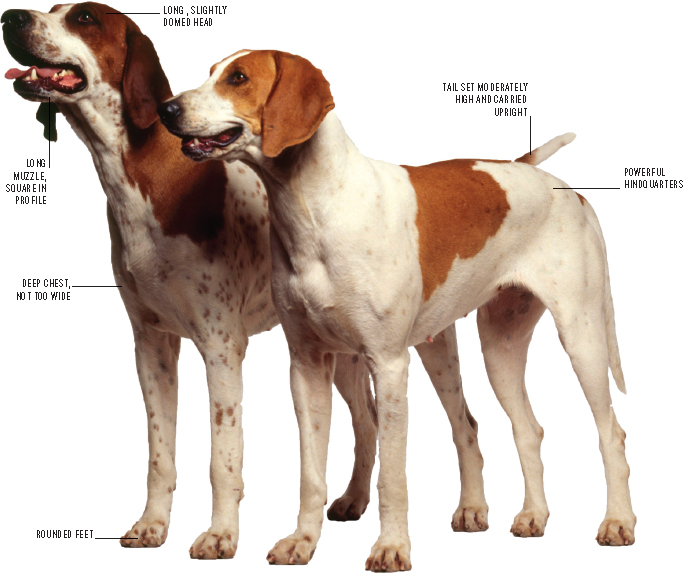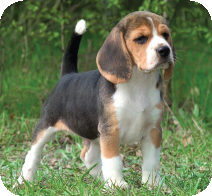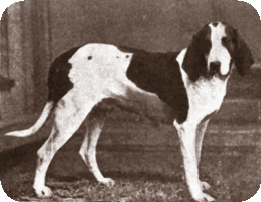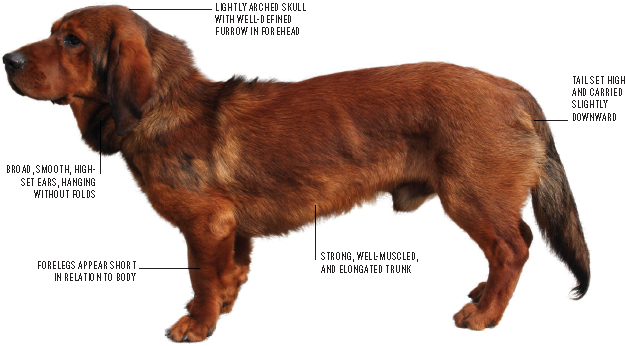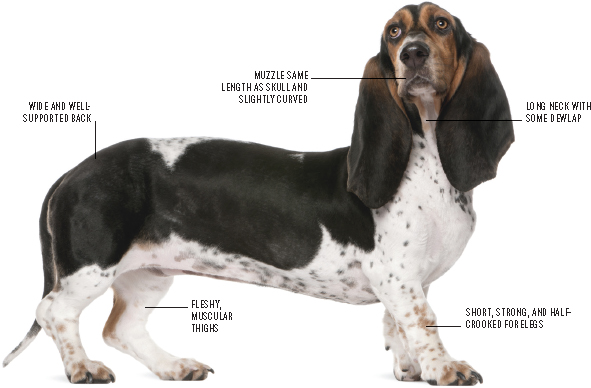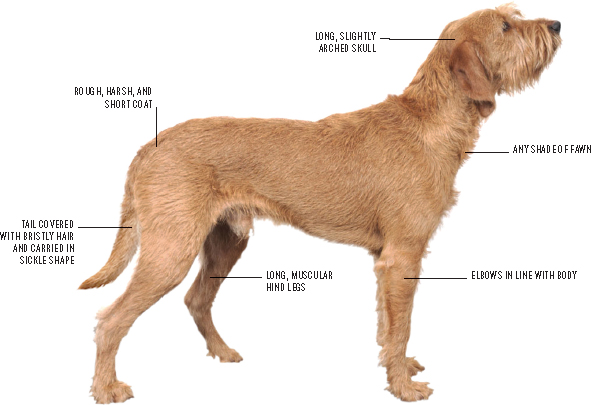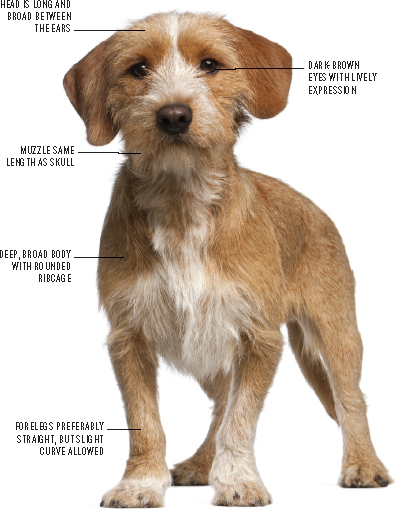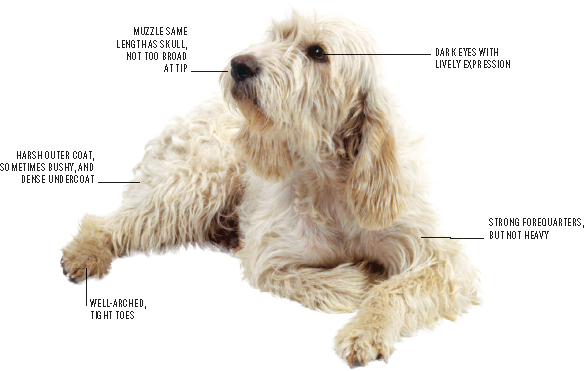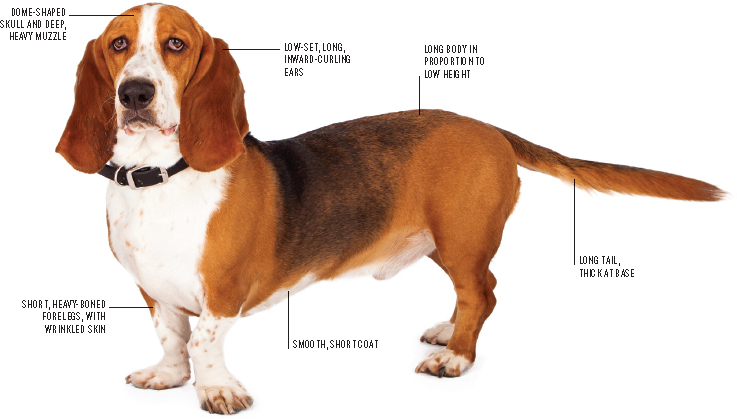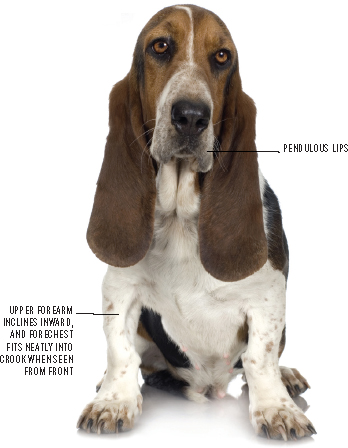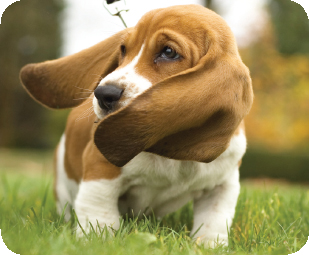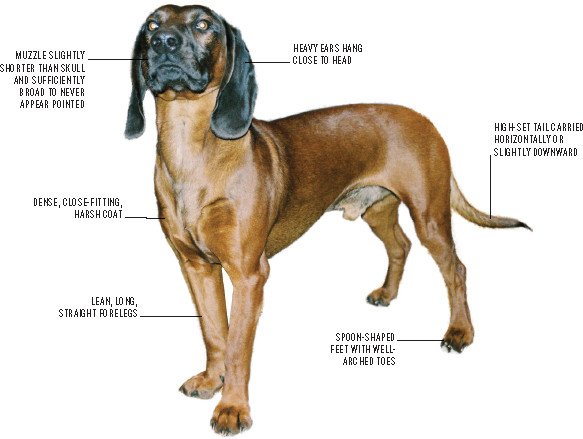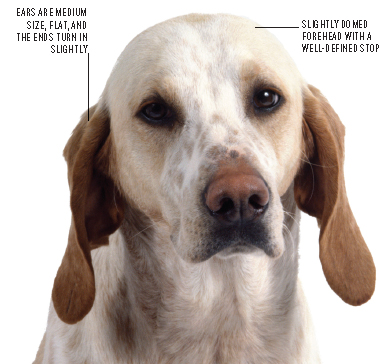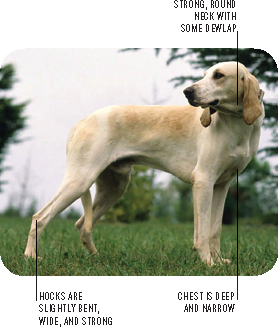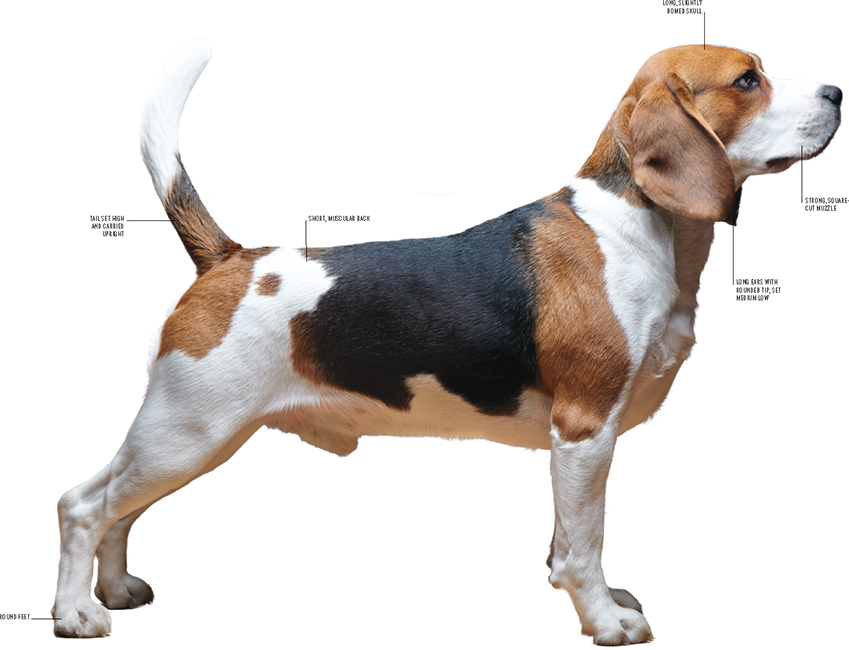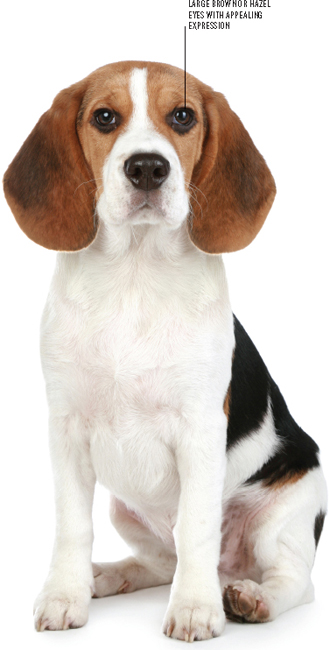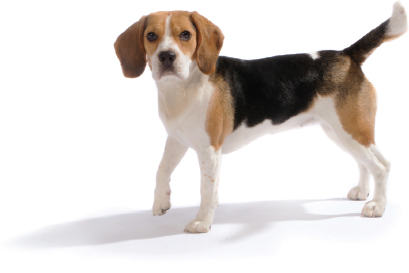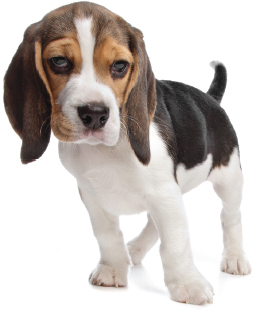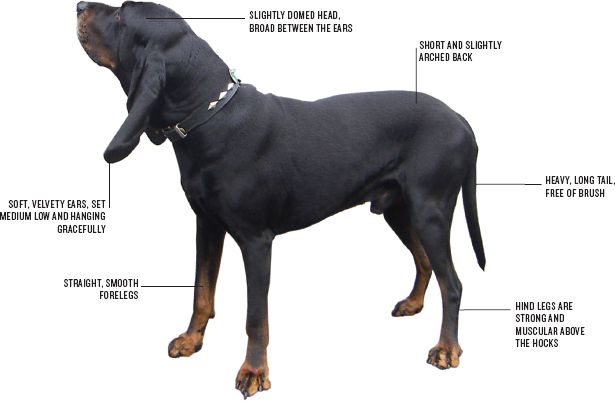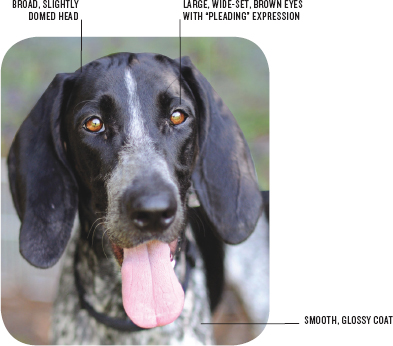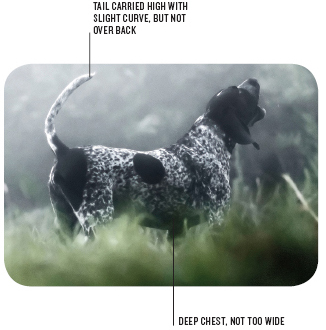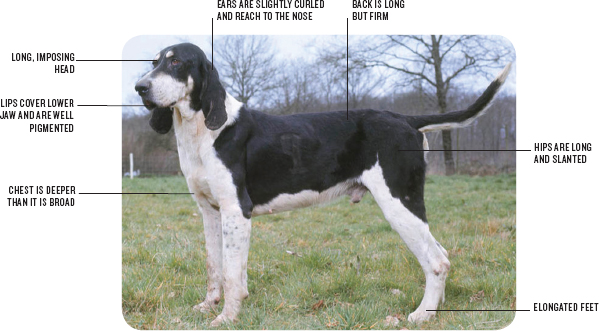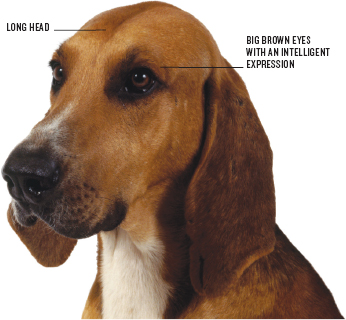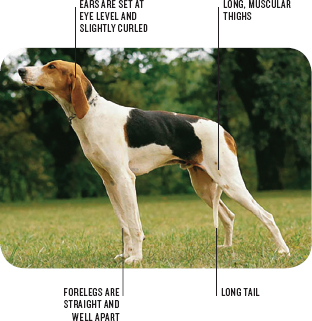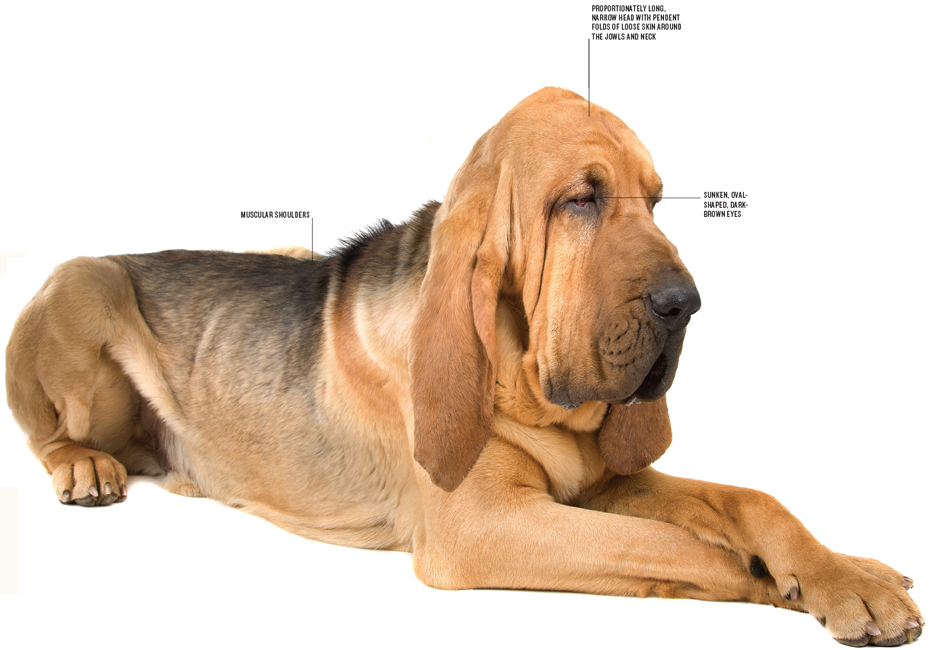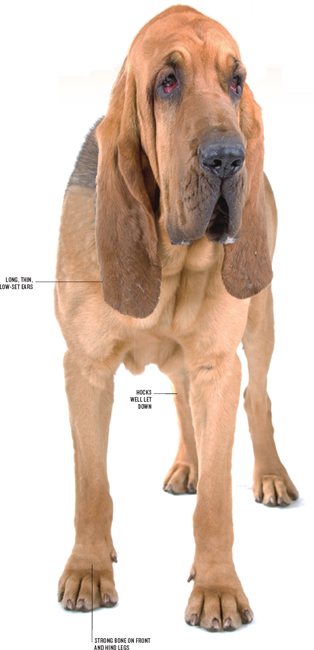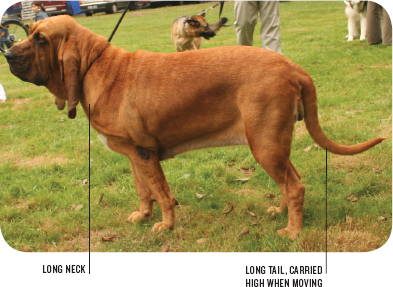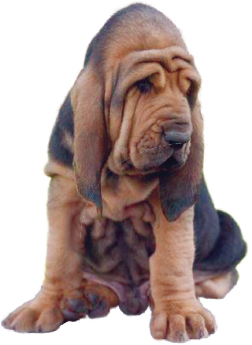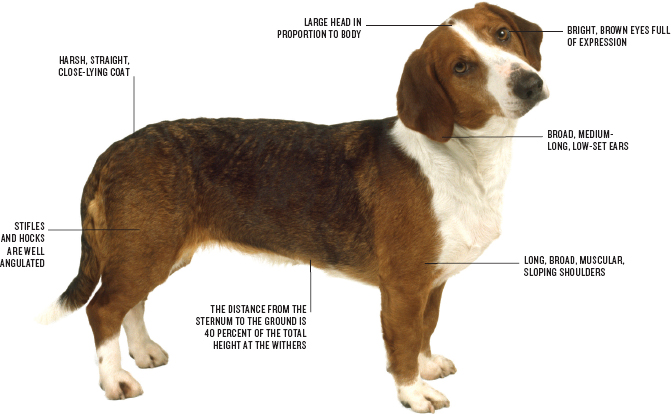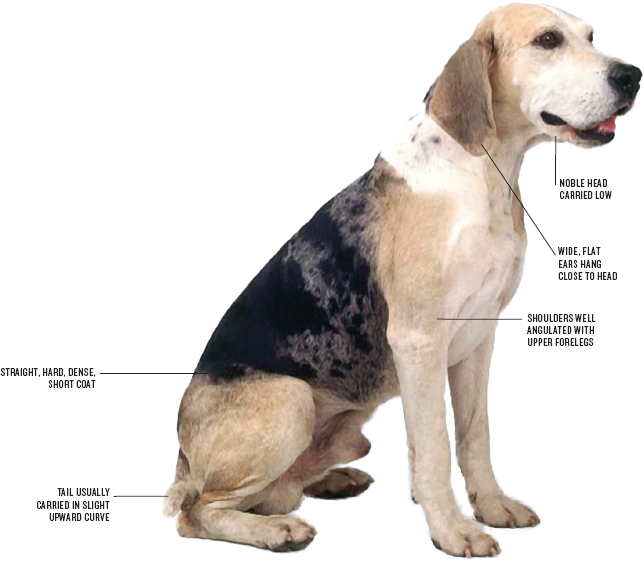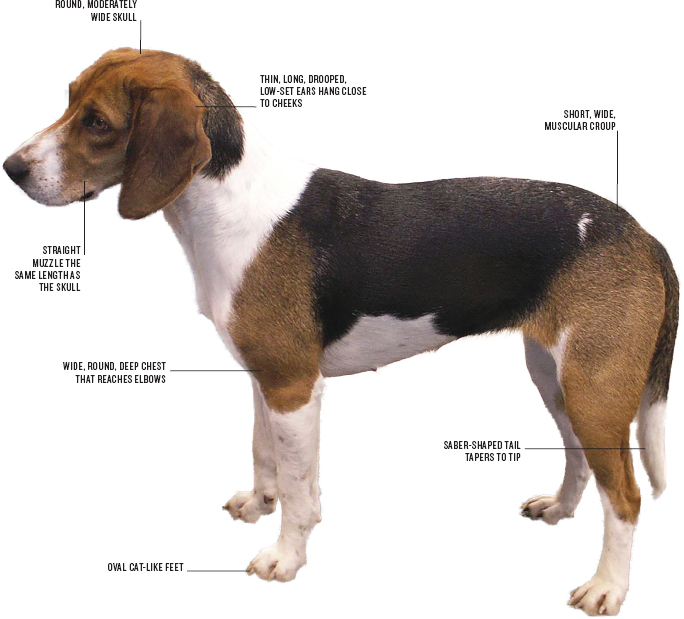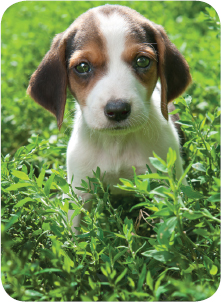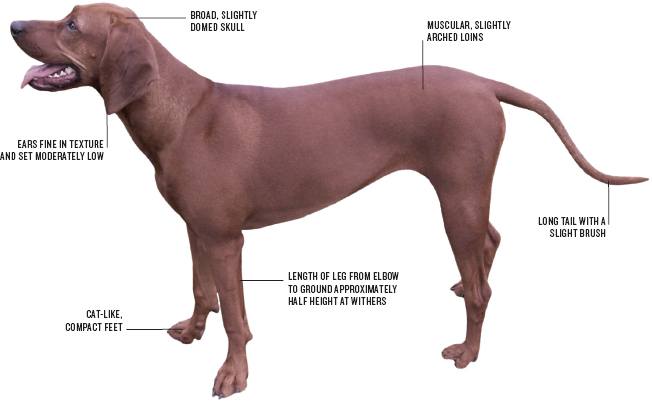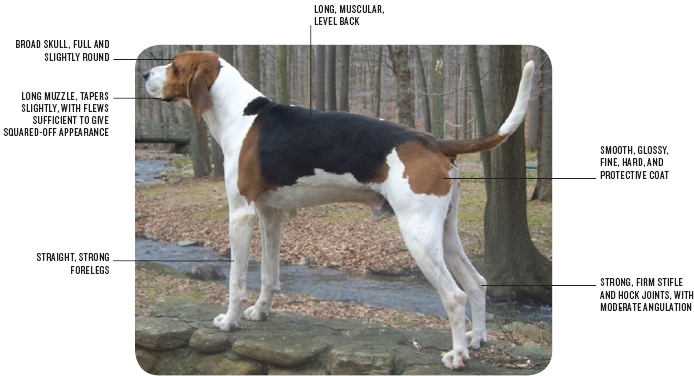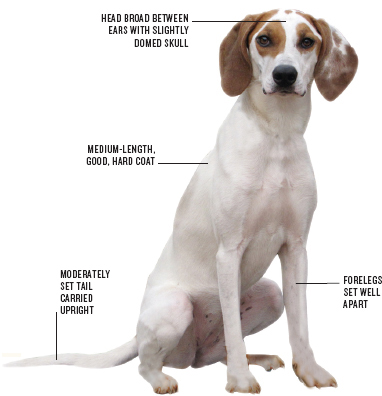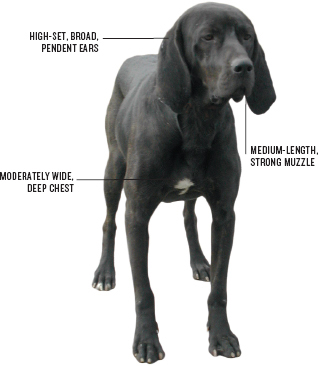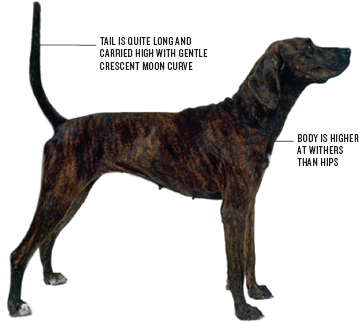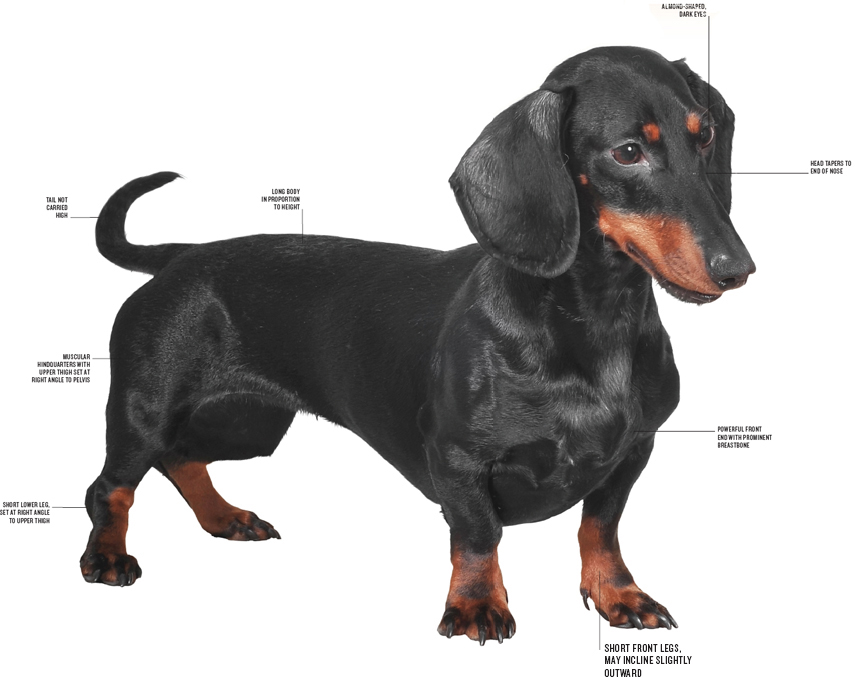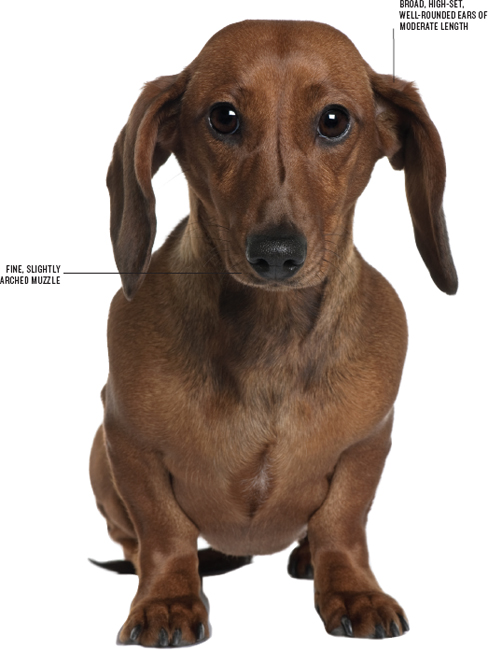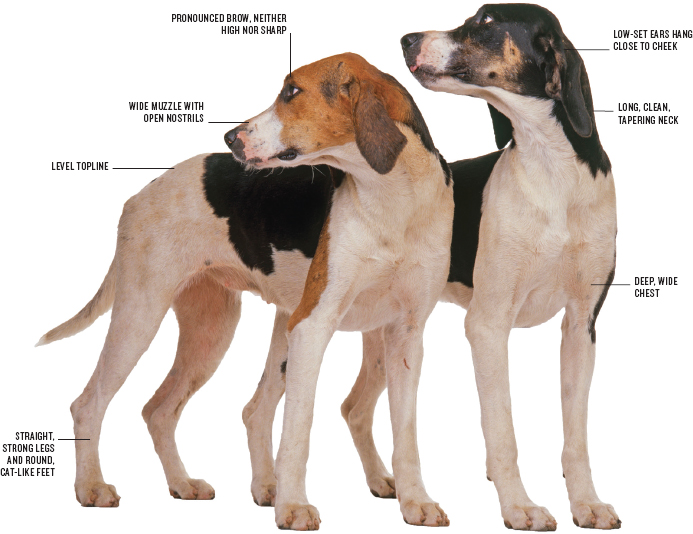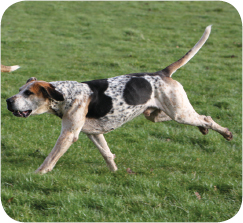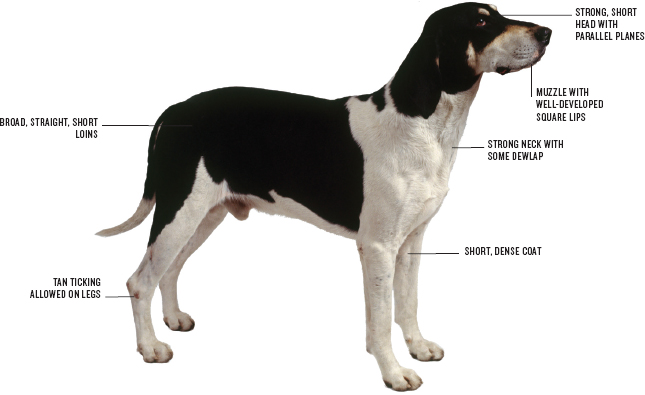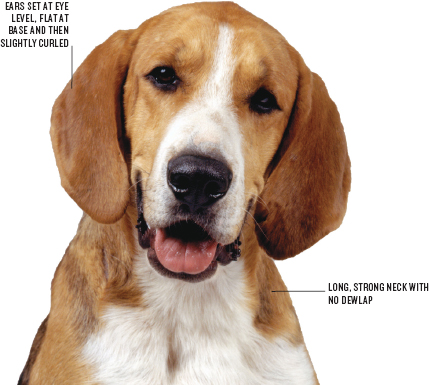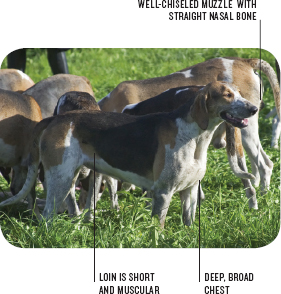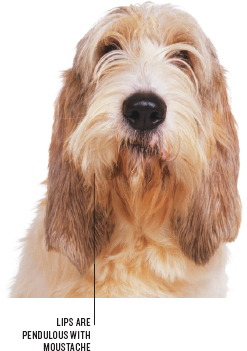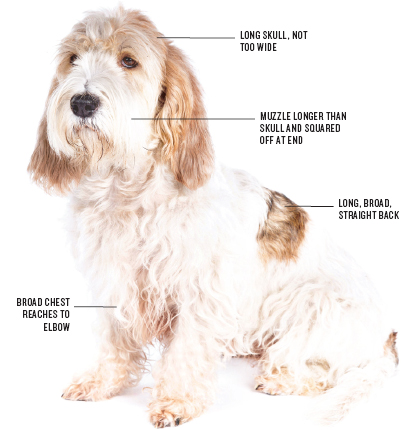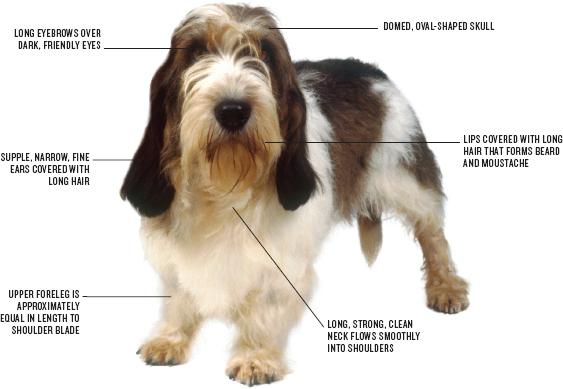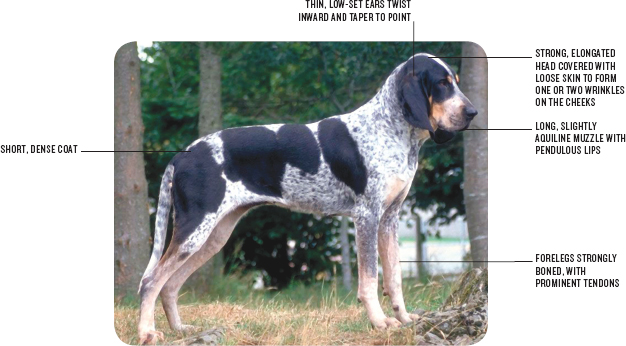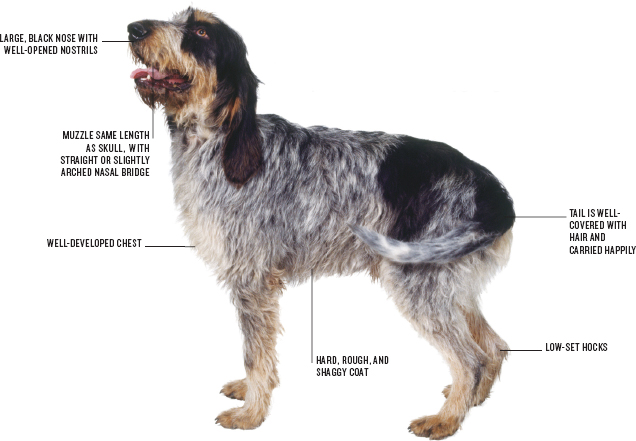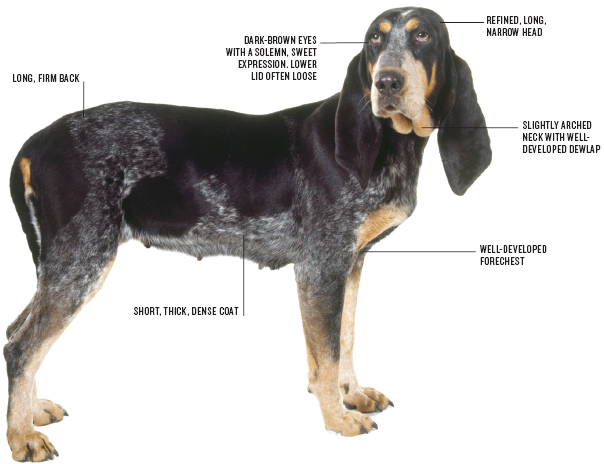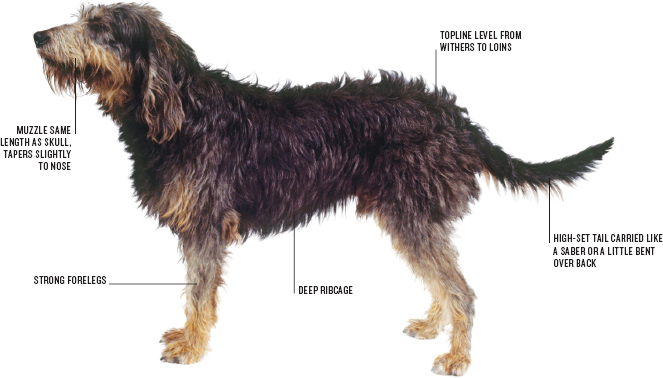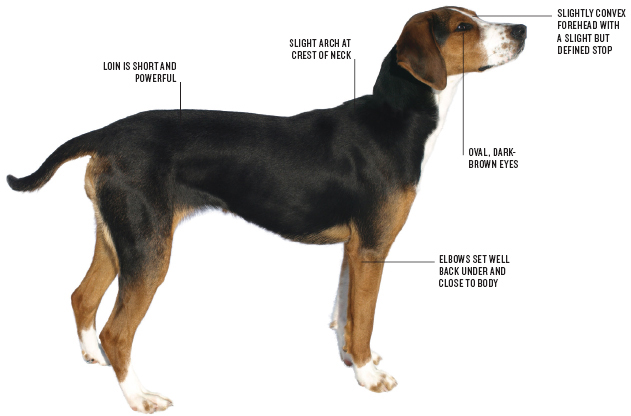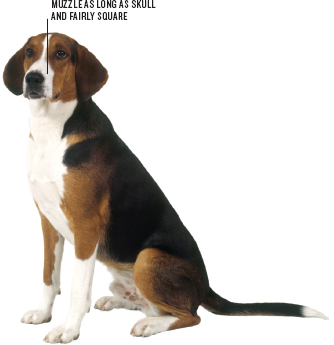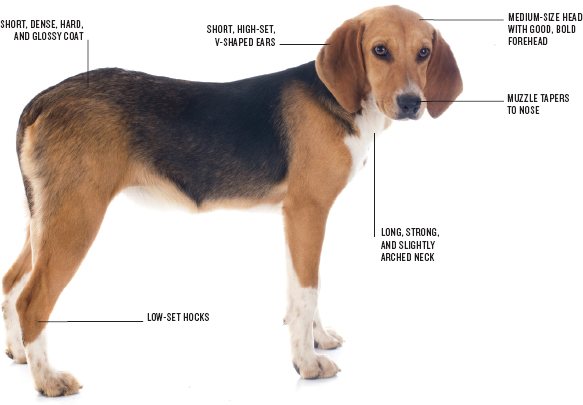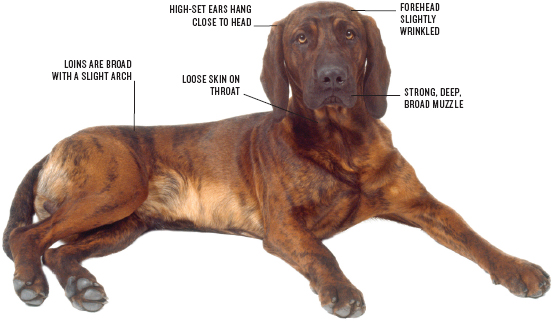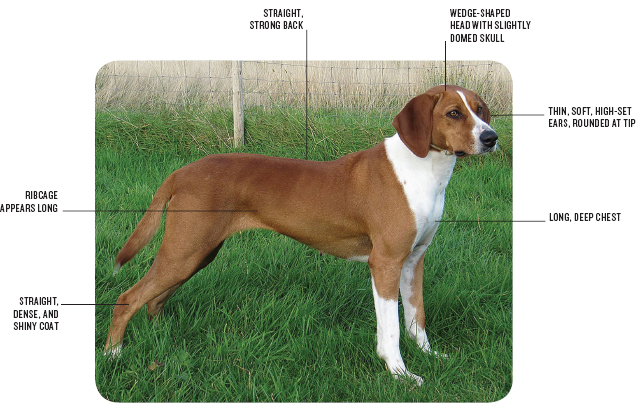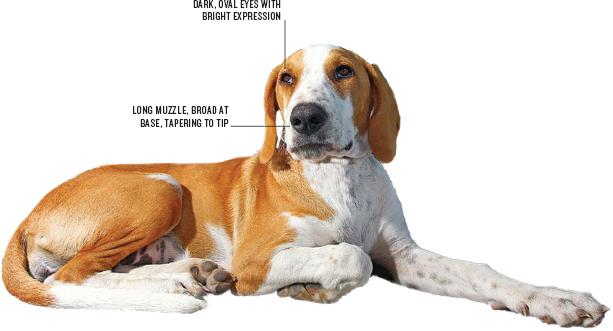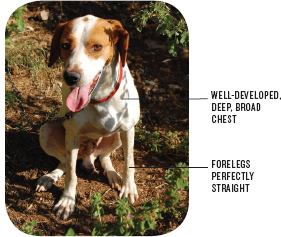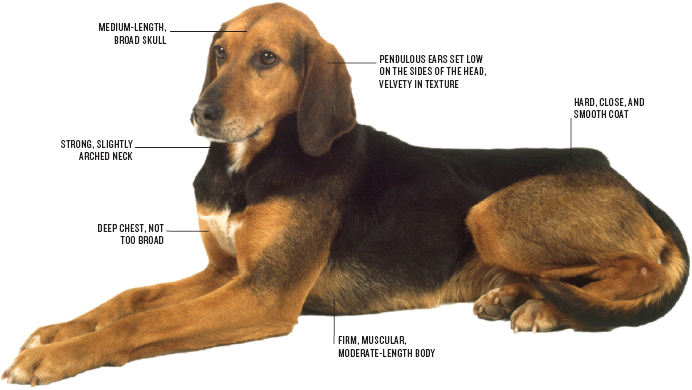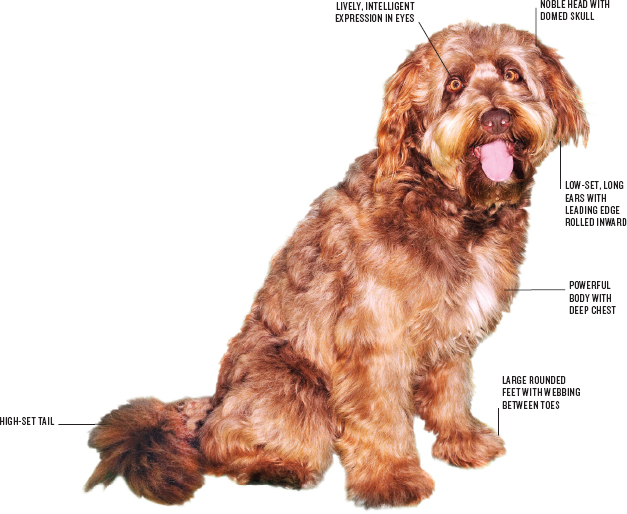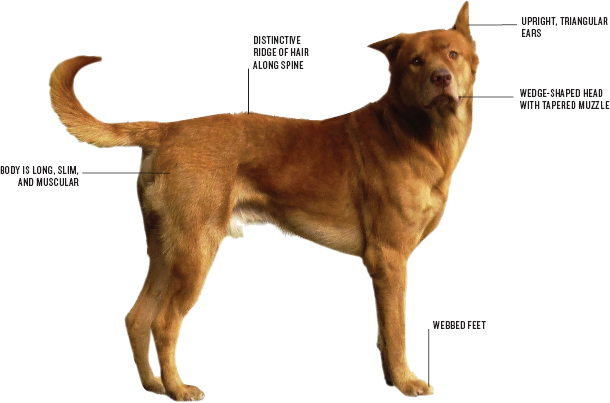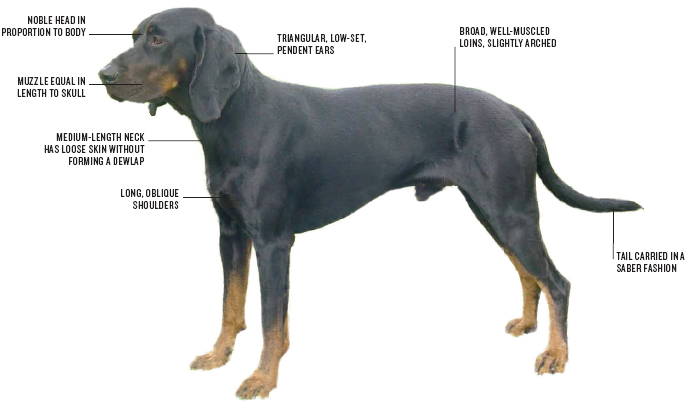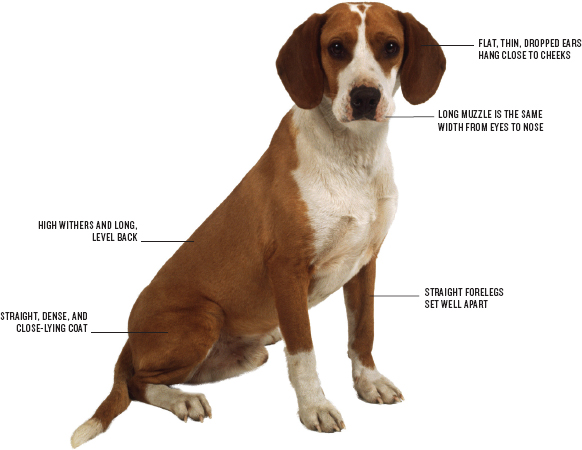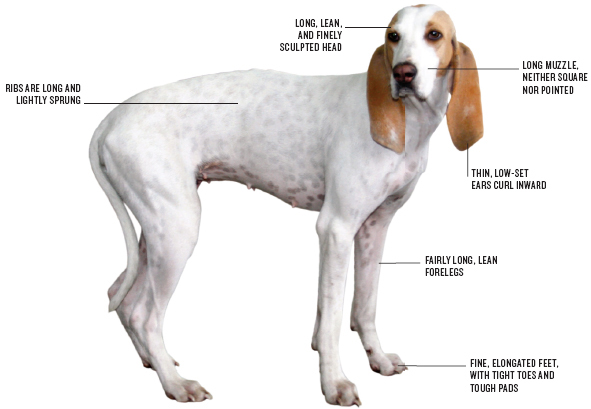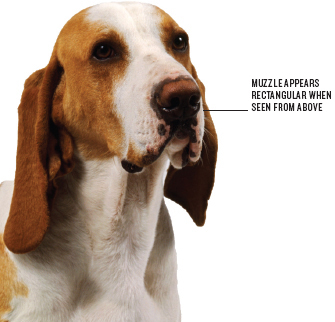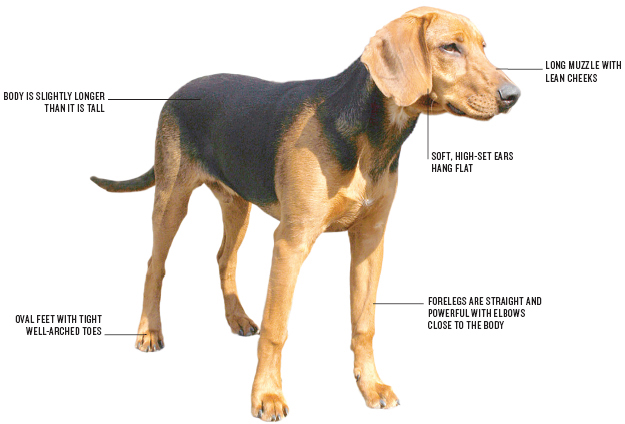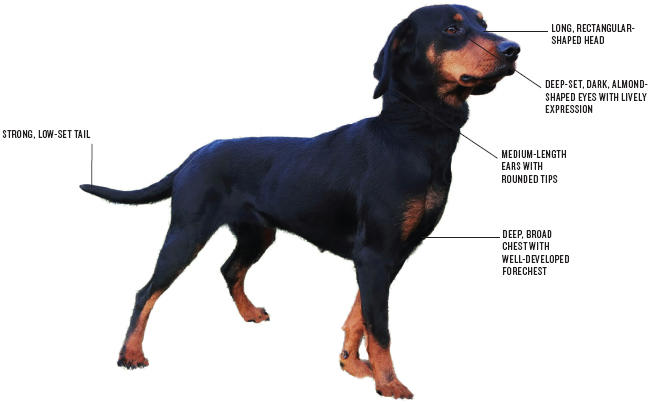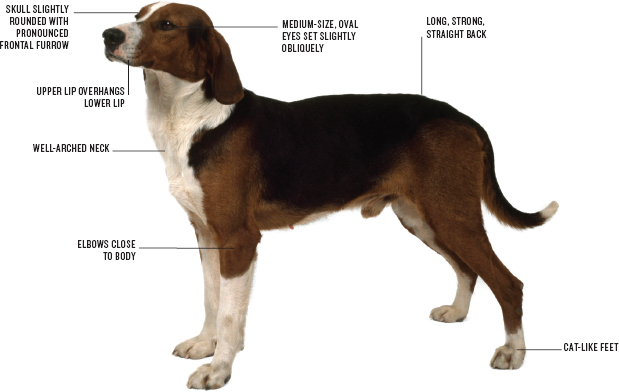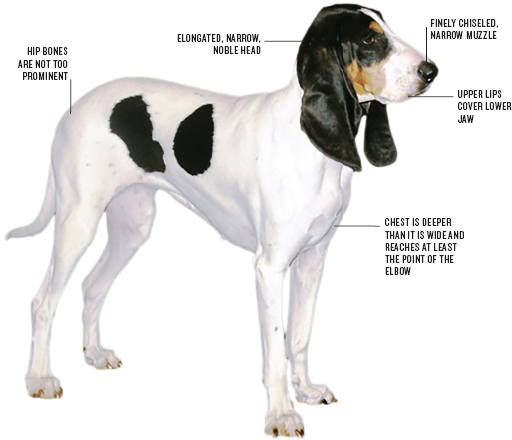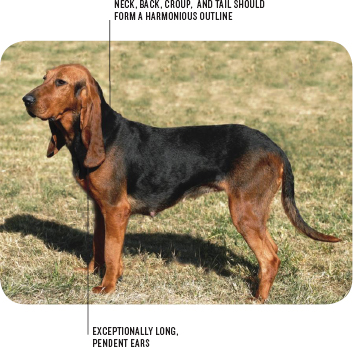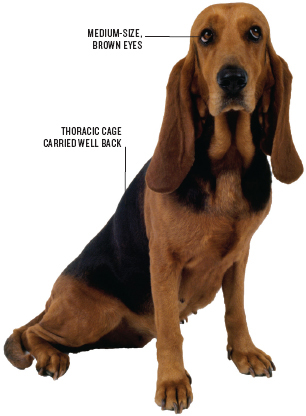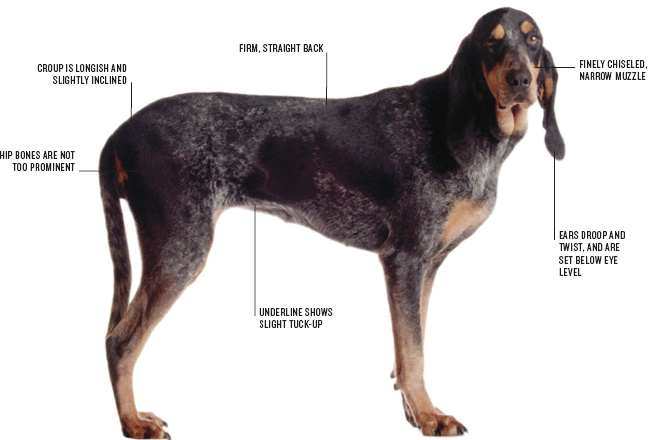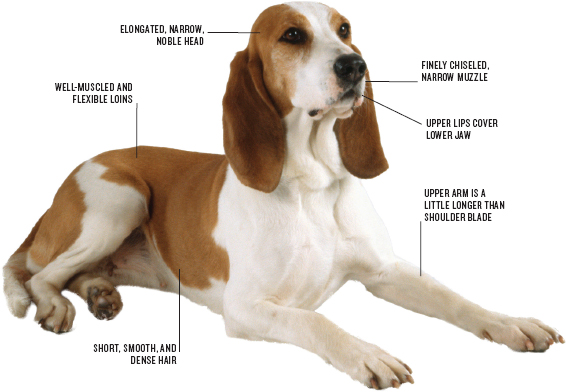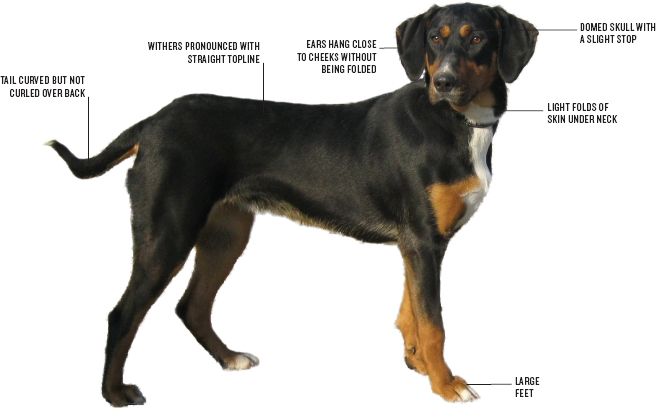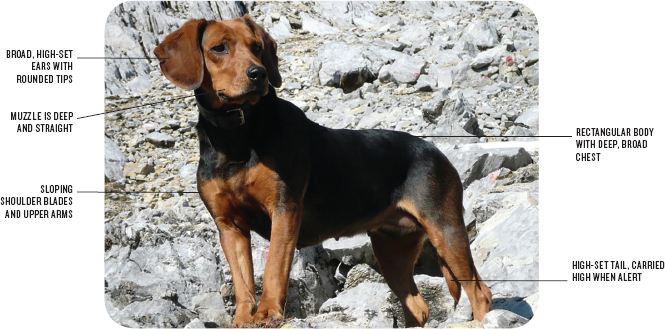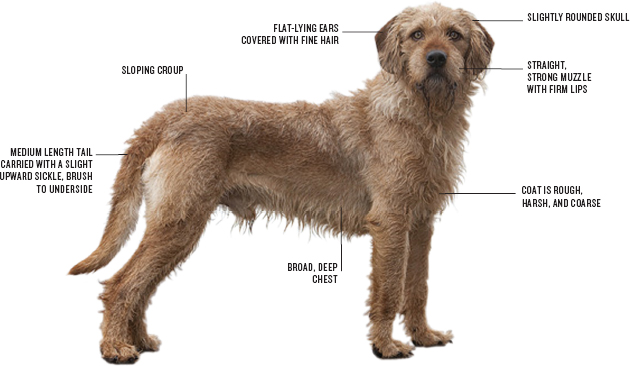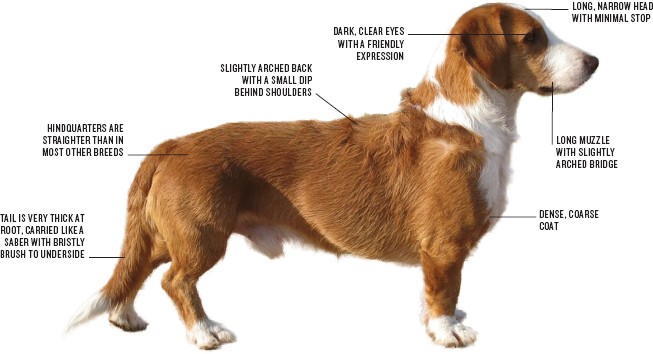SCENT HOUNDS
AMERICAN FOXHOUND : UNITED STATES
AT A GLANCE
Size: medium-large
Exercise needed:

Grooming needed:

Aptitudes: trailing fox
Height: 21–25 in.
Weight: 40–65 lb.
Average life expectancy: 11–13 yrs
AKC: hounds
CHARACTER
Affection

Playfulness

Friendliness to dogs

Friendliness to strangers

Ease of training

 HEALTH
HEALTH 
Generally very healthy, but hereditary problems can include hip dysplasia, deafness, and platelet abnormalities.
COMMON COAT COLORS
The American Foxhound can be any solid color from cream to red. It can also be particolored, ticked, or roan.
COAT CLOSE-UP
The American Foxhound traces to the seventeenth century and the efforts of Robert Brooke, a wealthy landowner who moved from England to Maryland, taking his foxhounds with him. He established a huge estate and bred his hounds to have speed and endurance to cope with all the wide open space in his new home. Fox hunting was becoming increasingly popular in the United States, and many new hunt clubs were established. The racy American Foxhounds were used for field trials, fox hunting with a single huntsman, following a trail, and hunting in packs. Today they are known as chiefly pack animals and do best living in this type of environment. American Foxhounds are gentle and pleasant in nature and generally get along well with other dogs.
HISTORY
President George Washington was a keen hunter and bred hounds that were significant in the development of the American Foxhound. He wrote in his diaries that he wanted to create a “perfect pack of hounds” by mixing English Foxhounds with Irish, French, and German hounds to produce a stronger, faster type suitable for the Virginia countryside.
ALPINE DACHSBRACKE : AUSTRIA
AT A GLANCE
Size: medium-small
Exercise needed:

Grooming needed:

Aptitudes: tracking, hunting, companion
Height: 13–17 in.
Weight: 33–40 lb.
Average life expectancy: 10–12 yrs
AKC: not recognized
CHARACTER
Affection

Playfulness

Friendliness to dogs

Friendliness to strangers

Ease of training

The Alpine Dachsbracke is a small but powerful scent hound that is believed to have been developed in the mid-nineteenth century and is linked to the kennels of Austria’s Crown Prince Rudolf. The crown prince’s gamekeepers kept Alpine Dachsbrackes (or their ancestors) and used the low-slung dogs for tracking wounded deer and scenting out hare and foxes. Crown Prince Rudolf is said to have taken some of his Dachsbrackes with him when hunting in Egypt and Turkey. These cheerful, bold dogs are primarily used for hunting, but they can make good companions and are noted for getting along with children and other dogs if properly introduced.
BASSET ARTÉSIEN NORMAND : FRANCE
AT A GLANCE
Size: small
Exercise needed:

Grooming needed:

Aptitudes: hunting, tracking, trailing, companion
Height: 12–14 in.
Weight: 33–44 lb.
Average life expectancy: 13–15 yrs
AKC: not recognized
CHARACTER
Affection

Playfulness

Friendliness to dogs

Friendliness to strangers

Ease of training

The Basset Artésien Normand was developed by Leon Verrier from the Artois Hound in the early twentieth century, and its breed standard is based on Verrier’s female Belette. The word basset means “low set,” which is an apt description of these keen scent hounds that can hunt singly or in packs. They are cheerful dogs, full of character, with a superb temperament that makes them good companions. They can be independent in nature and are known for their deep, loud voices.
GRIFFON FAUVE DE BRETAGNE : FRANCE
AT A GLANCE
Size: medium
Exercise needed:

Grooming needed:

Aptitudes: tracking, trailing, hunting, companion
Height: 19–22 in.
Weight: 35–45 lb.
Average life expectancy: 12–13 yrs
AKC: not recognized
CHARACTER
Affection

Playfulness

Friendliness to dogs

Friendliness to strangers

Ease of training

The Griffon Fauve de Bretagne is widely considered to be one of the oldest of the French hound breeds and dates back to the early Middle Ages. They were widespread in northern France and were typically used for hunting wolves in packs—a testament to their great bravery and tenacity. As the wolf population began to decline, breed numbers dropped, although they were still used to hunt deer, fox, hare, and wild boar. Following World War II, breeding initiatives have led to an increase in the numbers of this exceptionally gentle and charismatic hound.
BASSET FAUVE DE BRETAGNE : FRANCE
AT A GLANCE
Size: small
Exercise needed:

Grooming needed:

Aptitudes: hunting, tracking, trailing, companion
Height: 12–16 in.
Weight: 35–40 lb.
Average life expectancy: 11–14 yrs
AKC: not recognized
CHARACTER
Affection

Playfulness

Friendliness to dogs

Friendliness to strangers

Ease of training

The Basset Fauve de Bretagne is believed to have developed from the old French Fauve hounds, of which there were four types, divided by coat color and texture. Today only one survives, the Griffon Fauve de Bretagne. The Basset Fauve de Bretagne was probably created by breeding the smallest Griffons together, although no records exist. By the nineteenth century, however, there were packs of the small, courageous hounds living throughout France. In the twentieth century, the Basset Fauve de Bretagne was influenced by Basset Griffon Vendéen to improve its hunting skills, and Red Standard Wire Haired Dachshund improved the color. These are brave, tenacious hounds with superb temperaments that can make wonderful family companions.
BRIQUET GRIFFON VENDÉEN : FRANCE
AT A GLANCE
Size: medium
Exercise needed:

Grooming needed:

Aptitudes: tracking, trailing, hunting, companion
Height: 19–22 in.
Weight: 48–53 lb.
Average life expectancy: 12–14 yrs
AKC: not recognized
CHARACTER
Affection

Playfulness

Friendliness to dogs

Friendliness to strangers

Ease of training

The word briquet translates as “medium-size dog,” which is appropriate for this breed that was bred down in size from the larger Grande Griffon Vendéen. There are four Vendéen hounds: the two aforementioned, the Petit Basset Griffon Vendéen (the smallest), and the Grand Basset Griffon Vendéen. The Briquet was developed prior to World War I, but by World War II had almost disappeared, although they have since been re-established. The Briquet will pick up a cold or a hot trail and is a determined and tough hunting dog. They also make good family companions as long as they get plenty of exercise, but can be difficult to obedience train and often have their own strong opinions!
CHIEN D’ARTOIS : FRANCE
AT A GLANCE
Size: medium
Exercise needed:

Grooming needed:

Aptitudes: tracking, trailing, hunting, companion
Height: 21–23 in.
Weight: 62–66 lb.
Average life expectancy: 12–14yrs
AKC: not recognized
CHARACTER
Affection

Playfulness

Friendliness to dogs

Friendliness to strangers

Ease of training

This is an ancient breed of scent hound whose history traces back to the fifteenth century and the larger Grand Chien d’Artois from which it developed. The dogs were used for hunting in small packs, both on foot and to accompany hunters on horseback. They are mostly used on small game, but these brave hounds will also hunt wild boar, deer, and other large game. The breed was influenced by crossbreeding to gun-dog types in the nineteenth century and will occasionally point.
BASSET HOUND : FRANCE
AT A GLANCE
Size: small
Exercise needed:

Grooming needed:

Aptitudes: tracking, trailing, companion
Height: less than 14 in.
Weight: 40–60 lb.
Average life expectancy: 8–12 yrs
AKC: hounds
CHARACTER
Affection

Playfulness

Friendliness to dogs

Friendliness to strangers

Ease of training

 HEALTH
HEALTH 
Conditions that might be found in the Basset Hound include bleeding disorders, bloat, elbow and hip dysplasia, glaucoma, and luxating patella.
COMMON COAT COLORS
Basset Hounds can be any color from cream to red, including brown, and are usually particolored. Can be ticked or roan.
COAT CLOSE-UP
The charismatic Basset Hound, among the most recognizable of all breeds, originated in France during the Middle Ages. These low-slung dogs, along with their taller relative the Bloodhound, are used for the slow trail of game and for driving small game from dense undergrowth into open country where a hunter can access them. They are typically used in packs, although they can work alone, and are also a much-loved companion breed.
HISTORY
Basset Hounds are believed to have developed from the St. Hubert Hounds that were bred by monks at the Monastery of St. Hubert in Belgium. In the late seventh and early eighth centuries, Hubert supplied the aristocracy with hounds from his monastery. It is possible that the Basset arrived through genetic mutations of these large hounds resulting in short-legged dogs that were bred together.
BAVARIAN MOUNTAIN HOUND : GERMANY
AT A GLANCE
Size: medium-small
Exercise needed:

Grooming needed:

Aptitudes: hunting, tracking, trailing, companion
Height: 18–19 in.
Weight: 44–55 lb.
Average life expectancy: 10–12 yrs
AKC: not recognized
CHARACTER
Affection

Playfulness

Friendliness to dogs

Friendliness to strangers

Ease of training

The Bavarian Mountain Hound is one of Germany’s preeminent hunting dogs and has outstanding tracking and trailing abilities. These are one of the German “bloodhound” breeds in that they instinctively follow a blood trail, making them valuable for tracking wounded game. Their scenting ability is acute, and they can track a “cold” trail that is several days old. They have great stamina and endurance and are well suited to hunting in the mountains. These dogs form strong bonds with their owners but may be reserved with strangers.
BILLY : FRANCE
AT A GLANCE
Size: large
Exercise needed:

Grooming needed:

Aptitudes: hunting, tracking, trailing
Height: 22–28 in.
Weight: 52–70 lb.
Average life expectancy: 11–13 yrs
AKC: not recognized
CHARACTER
Affection

Playfulness

Friendliness to dogs

Friendliness to strangers

Ease of training

This rare breed of French hound was developed during the nineteenth century primarily by Monsieur Gaston Hublot du Rivault at his Chateau de Billy in Poitou, a province in west central France. The Billy was based on several old French hound breeds such as the Montaimboeuf, Ceris, and Larye, which no longer exist, and has had a more recent introduction of Foxhound blood. The Billy is an elegant-looking hound with a great turn of speed. They have exceptional scenting abilities and a deep, sonorous bay.
BEAGLE : ENGLAND
AT A GLANCE
Size: small
Exercise needed:

Grooming needed:

Aptitudes: trailing, tracking, hunting, therapy, companion
Height: under 13 in./ 13–15 in.
Weight: 18–30 lb.
Average life expectancy: 12–15 yrs
AKC: hound
CHARACTER
Affection

Playfulness

Friendliness to dogs

Friendliness to strangers

Ease of training

 HEALTH
HEALTH 
Generally healthy, but hereditary problems can include hip dysplasia and intervertebral disk disease.
COMMON COAT COLORS
The beagle can be any true hound color, but is commonly tricolored or white and tan.
COAT CLOSE-UP
The Beagle is a superb small hunting hound that has also become popular as a companion animal, particularly in the United States. Beagles have an engaging, lively, and often comical nature; they are highly entertaining, interactive, and affectionate. On the downside, and as is the case with most hound breeds, Beagles can be very noisy. They are suitable for urban living as long as their barking is managed and they are given plenty of exercise and diversions. Due to their pleasing temperament and compact size, Beagles are often used as therapy dogs, and also for bomb and drug detection.
HISTORY
Accounts of small hounds used for tracking hare date back to Xenophon (c. 430–354 BC) in Ancient Greece and his treatise On Hunting. The Romans probably took these small hounds on their conquest of Europe, including into England, where the Beagle developed. Many written accounts of small hounds of Beagle type indicate that various monarchs such as Edward II and Henry VII kept packs at the Royal kennels. The term “beagle” was introduced in the fifteenth century by Edward, Second Duke of York, in his treatise The Master of the Game. Early in their history, Beagles were bred in different sizes including the Glove or Pocket Beagle, so called because it could fit into a gauntlet cuff or a saddle bag. Elizabeth I kept a pack of Pocket Beagles and had her portrait painted with one of them. In the United States, Beagles are divided into two height divisions: 13 inches and 15 inches. The American Kennel Club registered the first Beagle in 1885, and the National Beagle Club of America was established in 1888.
BLACK AND TAN COONHOUND : UNITED STATES
AT A GLANCE
Size: medium-large
Exercise needed:

Grooming needed:

Aptitudes: hunting, tracking, trailing, treeing, companion
Height: 21–27 in.
Weight: 40–75 lb.
Average life expectancy: 10–12 yrs
AKC: hounds
CHARACTER
Affection

Playfulness

Friendliness to dogs

Friendliness to strangers

Ease of training

The American Black and Tan Coonhound is a stylish-looking hound that traces back to the nineteenth century to the southern United States. They were developed primarily from American Foxhounds with the addition of Bloodhound, which gave rise to the Black and Tan’s color; its long, pendent ears; and heavy frame. Black and Tans have superb scenting abilities and can follow a “cold” trail—one that is several days old. They are excellent tracking and treeing dogs and, as their name suggests, are particularly suited to hunting raccoons.
BLUETICK COONHOUND : UNITED STATES
AT A GLANCE
Size: large
Exercise needed:

Grooming needed:

Aptitudes: tracking, trailing, treeing, companion
Height: 21–27 in.
Weight: 45–100 lb.
Average life expectancy: 12–14yrs
AKC: hounds
CHARACTER
Affection

Playfulness

Friendliness to dogs

Friendliness to strangers

Ease of training

The Bluetick Coonhound was developed in the southern United States based on English Foxhounds bred to other hound types; the breed’s distinctive coloring is attributed to the influence of French breeds like the Grand Bleu de Gascogne. Blueticks are noted for their loud, drawn-out bay that reaches different pitches depending on the stage of the hunt. They are bred for tracking and treeing game and will hunt a wide variety, including bobcats, mountain lions, bears, and, most commonly, raccoons.
CHIEN FRANÇAIS BLANC ET NOIR : FRANCE
AT A GLANCE
Size: large
Exercise needed:

Grooming needed:

Aptitudes: tracking, trailing, hunting
Height: 24–28 in.
Weight: 55–65 lb.
Average life expectancy: 10–12 yrs
AKC: not recognized
CHARACTER
Affection

Playfulness

Friendliness to dogs

Friendliness to strangers

Ease of training

This upstanding breed exhibits all the classic hound features and, although originally developed for use on small game, is highly regarded for hunting large game such as deer. These dogs hunt in packs and retain strong pack instincts. They give good voice when hunting and are noted for their superb sense of smell and great staying power. The breed is believed to have been developed during the early 1900s by Henri de Falandre, a keen huntsman. He used a foundation of Gascon Saintongeois and Bleu de Gascogne with some English Foxhound to create the desired qualities of scenting ability, stamina, and temperament.
CHIEN FRANÇAIS TRICOLORE : FRANCE
AT A GLANCE
Size: large
Exercise needed:

Grooming needed:

Aptitudes: tracking, trailing, hunting
Height: 23–28 in.
Weight: 55–65 lb.
Average life expectancy: 10–12 yrs
AKC: not recognized
CHARACTER
Affection

Playfulness

Friendliness to dogs

Friendliness to strangers

Ease of training

This breed of medium to large French hound was, like the related Chien Français Blanc et Orange and the Chien Français Blanc et Noir, bred specifically to hunt large game. The hounds are always worked in packs and have a strong pack mentality, so they are not suited to living alone. They have a loud, deep bay, which is useful for the huntsman, and they can alter the tone and pitch of their bay depending on the stage of the hunt. They generally have kind natures but do not make good companion animals unless they are kept with other dogs in a rural location—they are happiest when doing what they were bred to do.
BLOODHOUND : BELGIUM/ENGLAND
AT A GLANCE
Size: large
Exercise needed:

Grooming needed:

Aptitudes: trailing, tracking, police, search and rescue, companion
Height: 23–27 in.
Weight: 80–110 lb.
Average life expectancy: 9–11 yrs
AKC: hounds
CHARACTER
Affection

Playfulness

Friendliness to dogs

Friendliness to strangers

Ease of training

 HEALTH
HEALTH 
Generally healthy, but hereditary problems can include gastric torsion, ear problems, skin-fold dermatitis, hip and elbow dysplasia, and eyelid problems.
COMMON COAT COLORS
COAT CLOSE-UP
The Bloodhound is one of the foremost trailing and tracking dogs in the world, with superlative scenting skills and the ability to track old trails over virtually any terrain—even occasionally across water. These dogs are used extensively by the police for tracking, as well as by search-and-rescue organizations. The breed name is based on the dog’s ability to follow a blood trail. Bloodhounds have exceptional temperaments: they are kind, gentle, and mostly good with children and other animals. However, they require lots of space, like to be with other dogs, have a tendency to bay loudly when excited, and can be difficult to obedience train. They are not, therefore, ideal for first-time dog owners.
HISTORY
Known as the Chien de Saint Hubert in most of continental Europe, the modern Bloodhound is generally believed to have developed from the ancient St. Hubert’s Hound, which was bred by monks at the Monastery of St. Hubert in Belgium from the eighth century. These hounds were often sent to kings and aristocrats as gifts to curry favor for the monastery, and accordingly, word of their fine hunting skills spread throughout Europe. The dogs were taken to England early in their history, possibly by William the Conqueror, and were described in detail in 1570 by John Caius in his book Of Englishe Dogges. Bloodhounds were first specifically mentioned in the United States in 1619 at the Virginia Assembly when it was made illegal to sell them to Native Americans. Bloodhounds were accepted by the American Kennel Club in 1885, but numbers remained low until the twentieth century. The breed is now relatively well supported in the United States and England.
DREVER : SWEDEN
AT A GLANCE
Size: small
Exercise needed:

Grooming needed:

Aptitudes: trailing, tracking, hunting
Height: 11–15 in.
Weight: not specified
Average life expectancy: 12–14 yrs
AKC: hounds
CHARACTER
Affection

Playfulness

Friendliness to dogs

Friendliness to strangers

Ease of training

The Drever is a low-slung, versatile hound primarily used for hunting deer at slow speeds, but can also hunt smaller game such as hare. The breed developed in the 1850s in Southern Germany, Austria, and Switzerland from the Westphalian Dachsbracke, and was imported to Sweden in the early twentieth century. In 1947 their name was changed to Drever—from the Swedish word drev, meaning “drive,” reflecting the breed’s ability to drive game to the hunter. Although good-natured, the Drever is not suited to a non-working lifestyle.
DUNKER : NORWAY
AT A GLANCE
Size: medium
Exercise needed:

Grooming needed:

Aptitudes: trailing, tracking, hunting, companion
Height: 18–22 in.
Weight: 25–39 lb.
Average life expectancy: 12–14 yrs
AKC: not recognized
CHARACTER
Affection

Playfulness

Friendliness to dogs

Friendliness to strangers

Ease of training

The Dunker is a specialized hare-hunting hound developed in the nineteenth century by Captain Wilhelm Dunker by crossbreeding several different hound types. In 1902 Norwegian hare hounds were divided into two groups, the Dunker and the Hygen Hound. The Dunker has a characteristically blue-marbled coat, although other colors are allowed. It is a determined hunter with a very pleasant nature, being affable and easy to train. Sadly, breed numbers are extremely low.
ESTONIAN HOUND : ESTONIA
AT A GLANCE
Size: medium-small
Exercise needed:

Grooming needed:

Aptitudes: trailing, tracking, hunting, agility, companion
Height: 16–21 in.
Weight: 30–45 lb.
Average life expectancy: 12–15 yrs
AKC: not recognized
CHARACTER
Affection

Playfulness

Friendliness to dogs

Friendliness to strangers

Ease of training

 HEALTH
HEALTH 
This is a very healthy and robust breed that suffers from few hereditary conditions.
COMMON COAT COLORS
Estonian Hounds can be any color from cream to red, including brown, and are usually parti-colored. Can be ticked or roan.
COAT CLOSE-UP
Rarely seen outside their native country in Eastern Europe, these scent hounds were developed in the mid-twentieth century from Dachshunds, Foxhounds, Beagles, Swiss Bernese Hounds, Swiss Lucerne Hounds, and Russian-Polish Hounds. The Estonian Hound is a highly efficient hunter of rabbits and foxes. They are personable dogs that can make good companions for an active home, and they excel at events like agility. However, like many pack hounds, they do not like to be left on their own, even for short periods.
The Estonian was specially developed as a hunting dog and can withstand the extreme cold of its native home.
HISTORY
The Estonian Hound is a relatively new breed and the only one to originate in Estonia. These scent hounds were developed in 1947 when the Ministry of Economy in the former USSR decided each Soviet Republic should have its own dog breed. It is now the national dog of Estonia.
REDBONE COONHOUND : UNITED STATES
AT A GLANCE
Size: medium-large
Exercise needed:

Grooming needed:

Aptitudes: hunting, tracking, trailing
Height: 21–27 in.
Weight: 45–80 lb.
Average life expectancy: 12–14 yrs
AKC: hound
CHARACTER
Affection

Playfulness

Friendliness to dogs

Friendliness to strangers

Ease of training

The stylish Redbone Coonhound was developed from red foxhound types from Scotland and Ireland and was brought into the country by immigrants in the eighteenth century. The foundation of the modern Redbone is attributed to George Birdsong of Georgia—a renowned breeder and hunter. Redbones are fast and agile over a variety of terrains and are excellent swimmers. In addition to hunting raccoons, the fearless Redbones hunt larger animals, including bobcats, bears, and cougars.
TREEING WALKER COONHOUND : UNITED STATES
AT A GLANCE
Size: large
Exercise needed:

Grooming needed:

Aptitudes: hunting, tracking, trailing, treeing, companion
Height: 20–27 in.
Weight: 45–80 lb.
Average life expectancy: 10–14 yrs
AKC: hound
CHARACTER
Affection

Playfulness

Friendliness to dogs

Friendliness to strangers

Ease of training

In the 1850s, Appalachian hunter George Washington Maupin acquired a hound of unknown heritage named Tennessee Lead and bred him extensively to Walker Hounds. The result was what eventually came to be known as the Treeing Walker Coonhound. These dogs are fast, hot-nosed hunters with an excellent voice and superb treeing ability. They are often used in competitions. They also have wonderful temperaments and can make excellent family dogs for an active home.
AMERICAN ENGLISH COONHOUND : UNITED STATES
AT A GLANCE
Size: medium-large
Exercise needed:

Grooming needed:

Aptitudes: trailing, tracking, treeing, hunting, watchdog, companion
Height: 22–25 in.
Weight: 40–65 lb.
Average life expectancy: 10–12 yrs
AKC: hound
CHARACTER
Affection

Playfulness

Friendliness to dogs

Friendliness to strangers

Ease of training

Also known as the English Coonhound or the Redtick Coonhound, this breed traces back to the earliest English Foxhounds brought to the southern United States in the mid-seventeenth century and crossed with local types adapted to the harsher climate and terrain. Today these are particularly agile, fast, and enduring hounds. They have an excellent voice, which they put to good use! The breed is known for its kind temperament and can fit into family life if given a lot of exercise, but they are happiest when hunting.
PLOTT : UNITED STATES
AT A GLANCE
Size: medium
Exercise needed:

Grooming needed:

Aptitudes: hunting, tracking, trailing, treeing, watchdog, companion
Height: 20–25 in.
Weight: 40–60 lb.
Average life expectancy: 11–13 yrs
AKC: hound
CHARACTER
Affection

Playfulness

Friendliness to dogs

Friendliness to strangers

Ease of training

This elegant all-American hound is a spirited and tenacious hunter that is fearless and will hunt all day. They are independent thinkers and can be headstrong and difficult to obedience train, although once they have been trained they are thoroughly rewarding dogs. They have a high activity requirement and are best suited to a hunting home. Plotts have a distinctive “chop”—a loud, ringing bark that they use when hunting. They may also be noisy if they become bored and are not ideal for an urban environment.
DACHSHUND : GERMANY
AT A GLANCE
Size: small
Exercise needed:

Grooming needed:

Aptitudes: trailing, tracking, hunting above and below ground, companion
Height: Standard 8–9 in. Miniature 5–6 in.
Weight: Standard over 11 lb./Miniature under 11 lb.
Average life expectancy: 12–14 yrs
AKC: hound
CHARACTER
Affection

Playfulness

Friendliness to dogs

Friendliness to strangers

Ease of training

 HEALTH
HEALTH 
Generally healthy, but hereditary problems can include intervertebral-disc disease and eye problems.
COMMON COAT COLORS
COAT CLOSE-UP
Dachshunds have three coat types: smooth, long, and wirehaired. The smooth is dense and short; the long haired is straight or slightly wavy; the wirehaired has a rough, harsh topcoat, and a dense undercoat.
In Germany the Dachshund, which translates as “badger hound,” is more commonly referred to as a Teckel. These low-slung, tenacious hunters are valued for their use on small game such as rabbit, hare, badger, and fox. They are unusual in that they can locate and track prey above ground and also dig down, kill, and retrieve prey that has gone underground. There are two recognized sizes of the Dachshund now—miniature and standard—but in Germany they are measured according to the circumferences of their chests, which determines into what size hole they can follow their prey. Dachshunds are perhaps more commonly known as companion animals today, but they are also still widely used for hunting, particularly in Germany. As companions, they are full of personality, loyal to their families, and love to have fun. They can, however, be wary of strangers and have a tendency to bark.
Dachshund puppies are very bright, so it is essential to keep them interested, alert, and happy, particularly when puppy training starts.
HISTORY
Long-bodied dogs low to the ground have been recorded since the Middle Ages. Accounts from the 1500s indicate that short-legged, powerful dogs were used in Germany for hunting badgers, and in 1685, author Christian Paullini refers to Dachshunds in his book on dogs. There are no records about how these dogs developed, but historians speculate that German Pinschers, bassetts, French hounds, and terriers might all have had some influence. Certainly the breed is designed for digging and hunting underground; they are extremely powerful but slender, and the structure of their front legs, which may incline outward slightly, allows for a free digging movement. Dachshunds became popular in England during the nineteenth century when Queen Victoria developed a fondness for them, and they made their way to the United States at around the same time. The American Kennel Club registered its first Dachshund in 1885, and the Dachshund Club of America was established in 1895.
ENGLISH FOXHOUND : ENGLAND
AT A GLANCE
Size: large
Exercise needed:

Grooming needed:

Aptitudes: trailing, tracking, hunting
Height: 23–25 in.
Weight: 55–75 lb.
Average life expectancy: 10–11 yrs
AKC: hound
CHARACTER
Affection

Playfulness

Friendliness to dogs

Friendliness to strangers

Ease of training

 HEALTH
HEALTH 
Generally healthy, but hereditary problems can include hip dysplasia and renal disease.
COMMON COAT COLORS
The coat can be any solid color from cream to red, including brown. Commonly particolored; can also be ticked or roan.
COAT CLOSE-UP
English Foxhounds are fast, agile, and extremely enduring hounds that hunt in packs and accompany horsemen. They hunt at a quick pace and are “hot-nosed” hunters, meaning they pick up and follow very fresh trails. The English Foxhound is very much a pack animal and is happiest when living and working in this type of environment. They are extremely sociable and get along well with other dogs. Foxhounds are not typically kept as purely pets, despite having lovely temperaments. They are kind-natured animals and generally good with children, but their greatest joy in life is to hunt.
HISTORY
English hounds were originally bred to hunt hare and stag. The English Foxhound developed gradually from the sixteenth century as fox hunting gained popularity. Fox hunting was formalized when George Villiers established the oldest fox hunt, the Bilsdale Hunt in Yorkshire, in 1668. Hounds were bred specifically to hunt fox and had to be very fast, agile enough to clear hedges and fences, and tough enough to keep going until they caught the prey. The Masters of Fox Hounds Association has registered Foxhound puppies since 1841 and currently represents 186 Foxhound packs in England, Wales, and Scotland. Some hunts maintain their own pedigree records that stretch back more than 300 years.
GRAND ANGLO-FRANÇAIS BLANC ET NOIR : FRANCE
AT A GLANCE
Size: large
Exercise needed:

Grooming needed:

Aptitudes: tracking, trailing, hunting
Height: 24–28 in.
Weight: 66–79 lb.
Average life expectancy: 10–12 yrs
AKC: not recognized
CHARACTER
Affection

Playfulness

Friendliness to dogs

Friendliness to strangers

Ease of training

The Grand Anglo-Français Blanc et Noir is one of three Grand Anglo-Français breeds that are all historic breeds derived through crossing English Foxhounds with French scent hounds. In many cases this resulted in hounds with both “hot-nose” and “cold-nose” qualities: they were able to follow a fresh, or “hot,” trail at great speed, but could also follow an old, or “cold,” trail with greater deliberation. The Grand Anglo-Français Blanc et Noir is hunted in large packs and used for hunting large game such as deer and wild boar, though it may also be used on smaller animals, such as fox. These dogs are not ideal companion animals; they are happiest living in a pack environment and hunting for a living.
GRAND ANGLO-FRANÇAIS TRICOLORE : FRANCE
AT A GLANCE
Size: large
Exercise needed:

Grooming needed:

Aptitudes: tracking, trailing, hunting
Height: 23–28 in.
Weight: 66–78 lb.
Average life expectancy: 10–12 yrs
AKC: not recognized
CHARACTER
Affection

Playfulness

Friendliness to dogs

Friendliness to strangers

Ease of training

This breed was developed in the 1800s by crossing French scent hounds with English Foxhounds. The three Grand Anglo-Francais hounds were not divided into separate breeds until the twentieth century when they were categorized primarily by coat color. The Grand Anglo-Français Tricolore largely derived through Poitevin (tricolored) and English Foxhound crosses and exhibits the characteristic robustness of the Poitevin with the scenting skills of the Foxhound. They are a tough and rugged breed that hunts on any terrain with vigor.
GRAND BASSET GRIFFON VENDÉEN : FRANCE
AT A GLANCE
Size: medium-small
Exercise needed:

Grooming needed:

Aptitudes: hunting, tracking, trailing, companion
Height: 15–17 in.
Weight: 39–44 lb.
Average life expectancy: 10–14 yrs
AKC: FSS
CHARACTER
Affection

Playfulness

Friendliness to dogs

Friendliness to strangers

Ease of training

The Grand Basset Griffon Vendéen is the fastest of all the basset scent hounds and is skilled in hunting hare, and all small game. These are lovely, charming dogs that can make wonderful companions for the right home. They also have enormous personalities, and are affectionate, kind, and loyal. First and foremost, however, they are hunters, and they will give chase if the opportunity arises. They also have a reputation for being escape artists, and so must have a very well-fenced yard.
PETIT BASSET GRIFFON VENDÉEN : FRANCE
AT A GLANCE
Size: small
Exercise needed:

Grooming needed:

Aptitudes: trailing, tracking, hunting, companion
Height: 13–15 in.
Weight: 35–45 lb.
Average life expectancy: 12–14 yrs
AKC: hound
CHARACTER
Affection

Playfulness

Friendliness to dogs

Friendliness to strangers

Ease of training

The Petit Basset Griffon Vendéen, the smallest of the four Vendéen breeds, traces to the La Vendee region on the western coast of France. They were developed to hunt small game over difficult terrain; they are also skilled rabbit and hare hunters, and have been used on birds. The Petit Basset and the Grand Basset were not given their own standards until the 1950s. The Petit is a wonderful addition to an active home and thrives on diversions and exercise. These are intelligent dogs with big personalities and a propensity to bark when bored.
GRAND BLEU DE GASCOGNE : FRANCE
AT A GLANCE
Size: large
Exercise needed:

Grooming needed:

Aptitudes: tracking, trailing, hunting
Height: 23–28 in.
Weight: 70–80 lb.
Average life expectancy: 12–14 yrs
AKC: not recognized
CHARACTER
Affection

Playfulness

Friendliness to dogs

Friendliness to strangers

Ease of training

One of the oldest and finest hound breeds, the Grand Bleu is thought to have developed from hounds brought into France by the seafaring Phoenicians, and the now extinct Chien de Courant. These are one of the largest hound breeds and are extremely powerful. They hunt at a slow but persistent pace and have an exceptional voice. They are used on large game, such as deer and boar, and are hunted in packs. Their pack instinct is very strong, and although they have lovely temperaments they are happiest in a hunting environment.
GRIFFON BLEU DE GASCOGNE : FRANCE
AT A GLANCE
Size: medium
Exercise needed:

Grooming needed:

Aptitudes: tracking, trailing, hunting, companion
Height: 19–23 in.
Weight: 35–40 lb.
Average life expectancy: 10–12 yrs
AKC: not recognized
CHARACTER
Affection

Playfulness

Friendliness to dogs

Friendliness to strangers

Ease of training

One of the four Bleu de Gascogne breeds, the Griffon is distinctive from the other three through its wiry coat. All three share similar roots and developed in the Pyrenean region of Gascony in southwestern France. The Griffon Bleu de Gascogne is believed to have developed through crossing the Grand Bleu de Gascogne with the the Griffon Nervais and possibly the Grand Griffon Vendéen. They are an excellent hunting dog and used on a variety of game in a pack or singly. They are noted for their calm, affable temperaments and easygoing nature.
PETIT BLEU DE GASCOGNE : FRANCE
AT A GLANCE
Size: small
Exercise needed:

Grooming needed:

Aptitudes: trailing, tracking, hunting, companion
Height: 13–15 in.
Weight: 40–50 lb.
Average life expectancy: 12–14 yrs
AKC: not recognized
CHARACTER
Affection

Playfulness

Friendliness to dogs

Friendliness to strangers

Ease of training

This ancient breed of scent hound is descended from the Grand Bleu de Gascogne and was developed in Gascony Province, on the southwest coast of France. The Petit Bleu de Gascogne was originally developed to hunt small game, whereas the Grand was used on large game. The Petit is noted for hunting hare, and hunts methodically at a relatively moderate speed. They are pack animals and are happiest in a pack environment.
GRIFFON NIVERNAIS : FRANCE
AT A GLANCE
Size: medium-large
Exercise needed:

Grooming needed:

Aptitudes: tracking, trailing, hunting, companion
Height: 21–25 in.
Weight: 50–55 lb.
Average life expectancy: 10–12 yrs
AKC: not recognized
CHARACTER
Affection

Playfulness

Friendliness to dogs

Friendliness to strangers

Ease of training

The Griffon Nivernais is most associated with the mountains of central France where they were bred to hunt wolves and wild boar. This is an exceptionally brave breed that will hunt all day in any weather, and never backs down from its prey. Like many hound breeds, these dogs also have wonderful temperaments, and although they are generally pack dogs, they can adapt to being companions as long as they have lots of activity and are not left on their own.
FINNISH HOUND : FINLAND
AT A GLANCE
Size: medium
Exercise needed:

Grooming needed:

Aptitudes: trailing, tracking, hunting, companion
Height: 20–24 in.
Weight: 33–53 lb.
Average life expectancy: 11–12 yrs
AKC: not recognized
CHARACTER
Affection

Playfulness

Friendliness to dogs

Friendliness to strangers

Ease of training

The Finnish Hound was developed from the eighteenth century by breeders who wanted to create a hound that was suited to the difficult, snowy, mountainous terrain and harsh climate of Finland. Foxhounds, Harriers, German, Swiss, and Polish hounds were used in the breed foundation, along with Russian hounds and local Finnish dogs. The first breed standard was written in 1893, but the modern standard was adopted in 1932. The breed is very popular in Finland for hunting hare and fox and is noted for its excellent voice. They are not commonly found outside Finland.
HAMILTONSTÖVARE : SWEDEN
AT A GLANCE
Size: medium
Exercise needed:

Grooming needed:

Aptitudes: tracking, trailing, hunting, agility, companion
Height: 19–24 in.
Weight: 50–60 lb.
Average life expectancy: 12–14 yrs
AKC: FSS
CHARACTER
Affection

Playfulness

Friendliness to dogs

Friendliness to strangers

Ease of training

The Hamiltonstövare traces to the 1800s, when it was developed by Count Adolf Patrick Hamilton, the founder of the Swedish Kennel Club. He wanted to establish a hound that could hunt hare and fox across difficult terrain in harsh weather. He used English Foxhounds, Harriers, and three German hounds that are now extinct; the foundation dogs were named Pang and Stella. The Hamiltonstövare is always hunted on its own or in a pair, never a pack. They are versatile, friendly, outgoing dogs that can make companions for an active home.
HARRIER : ENGLAND
AT A GLANCE
Size: medium-small
Exercise needed:

Grooming needed:

Aptitudes: tracking, trailing, hunting, companion
Height: 19–21 in.
Weight: 48–58 lb.
Average life expectancy: 10–12 yrs
AKC: hound
CHARACTER
Affection

Playfulness

Friendliness to dogs

Friendliness to strangers

Ease of training

The Harrier is an ancient English breed that sits halfway between the English Foxhound and the Beagle. The first recorded pack of Harriers in England was established by Sir Elias de Midhope in 1260. Their popularity quickly spread throughout western England and into Wales. The dogs are used to hunt fox and hare. They hunt in packs, generally with hunters on horseback, but they can also hunt with men on foot. They are pleasant-natured hounds, sociable and friendly, but can also be very noisy and independent.
HANOVER HOUND : FRANCE
AT A GLANCE
Size: medium
Exercise needed:

Grooming needed:

Aptitudes: tracking, trailing, hunting, agility, companion
Height: 19–21 in.
Weight: 55–88 lb.
Average life expectancy: 10–14 yrs
AKC: not recognized
CHARACTER
Affection

Playfulness

Friendliness to dogs

Friendliness to strangers

Ease of training

The Hanover Hound traces back to the liam hounds of the Middle Ages; these were “leash hounds” that hunted on a leash, held by a hunter on foot. As hunting methods changed with the invention of firearms, it became necessary to develop hounds that could search for wounded game. The old leash hound proved the most adapted to this, so they were bred specifically for these qualities. The Hanover Hound was established on the large hunting estates in the Kingdom of Hanover, where its breeding was carefully monitored. A breed club was founded in 1894 to oversee their continued success. The Hanover Hound is used solely for large game and is a specialist in tracking cloven-hoof game.
HYGENHUND : NORWAY
AT A GLANCE
Size: medium
Exercise needed:

Grooming needed:

Aptitudes: trailing, tracking, hunting, companion
Height: 21–20 in.
Weight: 44–55 lb.
Average life expectancy: 12–14 yrs
AKC: not recognized
CHARACTER
Affection

Playfulness

Friendliness to dogs

Friendliness to strangers

Ease of training

This rare breed was developed by Hans Fredrik Hygen in the 1830s. Hygen’s son continued his breeding program and was a founding member of the Special Club for Norwegian Hare Hounds, founded in 1902. It was also Hygen Junior who wrote the first breed standard for the Hygenhund in the same year. These dogs are easy to train and have an easygoing, affectionate nature.
ISTRIAN SHORTHAIRED HOUND : CROATIA
AT A GLANCE
Size: medium-small
Exercise needed:

Grooming needed:

Aptitudes: trailing, tracking, hunting, companion
Height: 18–20 in.
Weight: 37–42 lb.
Average life expectancy: 12–14 yrs
AKC: not recognized
CHARACTER
Affection

Playfulness

Friendliness to dogs

Friendliness to strangers

Ease of training

Hounds of similar appearance to the Istrian Shorthaired Hound appear in art as far back as the fifteenth century, so historians believe that this is a very ancient breed, although no actual records exist. The Istrian is considered to be the oldest hound breed in the Balkan region, and gave rise to the slightly larger, wire-coated Istrian Coarse-haired Hound. Both types were prized for their hunting skills on hare, fox, and rabbit, and both are still used for hunting today. They have a good, solid, calm temperament, but they can be prone to barking.
KERRY BEAGLE : IRELAND
AT A GLANCE
Size: medium
Exercise needed:

Grooming needed:

Aptitudes: trailing, tracking, hunting, companion
Height: 22–24 in.
Weight: 40–60 lb.
Average life expectancy: 12–14 yrs
AKC: not recognized
CHARACTER
Affection

Playfulness

Friendliness to dogs

Friendliness to strangers

Ease of training

Although the Kerry Beagle is one of Ireland’s oldest hounds, the breed is not recognized by any of the major kennel clubs and is rarely heard of beyond its homeland. They were originally bred for tracking large game, but are now mostly used for small game such as hare, which they hunt in packs with hunters on foot. The Kerry Beagle is an outgoing, sociable dog that requires a lot of exercise and is not suited to urban living. They are generally good with children and other dogs, but are prone to barking when left unattended.
OTTERHOUND : ENGLAND
AT A GLANCE
Size: large
Exercise needed:

Grooming needed:

Aptitudes: hunting, companion
Height: 24–27 in.
Weight: 80–115 lb.
Average life expectancy: 10–13 yrs
AKC: hound
CHARACTER
Affection

Playfulness

Friendliness to dogs

Friendliness to strangers

Ease of training

The Otterhound is a delightful, though rare, breed that, as its name suggests, was originally bred to hunt otters. When otter hunting was banned in England in 1978, there was a huge decline in breed numbers. These dogs are of ancient origin and are believed to have been smooth coated before the seventeenth century. The earliest mention of a pack of Otterhounds dates to 1653. Their tremendous, shaggy, protective coat is possibly the result of rough-coated French Hounds introduced to the breed in the 1800s. Otterhounds have wonderful personalities and are very affectionate; they make excellent companion animals.
PHU QUOC RIDGEBACK DOG : VIETNAM
AT A GLANCE
Size: medium
Exercise needed:

Grooming needed:

Aptitudes: hunting, watchdog, companion
Height: 20–25 in.
Weight: 40–55 lb.
Average life expectancy: over 10 yrs
AKC: not recognized
CHARACTER
Affection

Playfulness

Friendliness to dogs

Friendliness to strangers

Ease of training

The rare Phu Quoc Ridgeback is one of only three ridgeback breeds in the world. It is found on Phu Quoc Island off Vietnam’s southern Kien Giang province, and is an exceptional athlete. These dogs have keen scenting abilities on hot and cold trails, are capable of great speed, and are also excellent swimmers. They generally have good temperaments but can be inclined to bark, and because they are exceptional jumpers, they need a well-fenced, secure yard. The breed is not recognized by any major registry, and no official standard exists.
POLISH HOUND : POLAND
AT A GLANCE
Size: medium-large
Exercise needed:

Grooming needed:

Aptitudes: hunting, tracking, trailing, companion
Height: 21–26 in.
Weight: 44–60 lb.
Average life expectancy: 13–14 yrs
AKC: not recognized
CHARACTER
Affection

Playfulness

Friendliness to dogs

Friendliness to strangers

Ease of training

Hounds are first mentioned in Poland in the fourteenth century. They were used by the aristocracy to hunt large and small game. Polish Hounds are described as being mostly black and tan and having a deep, rich bark when on the hunt. In the 1600s, Poland began several centuries of political turmoil, which affected the dogs’ bloodline: many kennels were lost, and the breed was not kept pure. By the twentieth century, the original Polish Hound had almost disappeared. The breed was re-established in 1959 by hunt enthusiast Colonel Peter Kartawik based largely on three dogs: Storm, Zorka, and Chita. Polish Hounds have wonderful temperaments, but are inclined to be independent and noisy.
POLISH HUNTING DOG : POLAND
AT A GLANCE
Size: medium
Exercise needed:

Grooming needed:

Aptitudes: hunting, tracking, trailing, agility, watchdog, companion
Height: 20–23 in.
Weight: 46–55 lb.
Average life expectancy: 12–14 yrs
AKC: not recognized
CHARACTER
Affection

Playfulness

Friendliness to dogs

Friendliness to strangers

Ease of training

There is a long history of scent hounds in Poland that is entwined with the fortunes of the aristocracy. The Polish Hunting Dog was largely developed during the mid-twentieth century in the Podkarpacie region of Poland by the famous cynologist, Jozef Pawuslewicz. He wrote the first breed standard for Polish Hunting Dogs, and through his efforts, the Polish Cynological Association accepted the breed. These are energetic dogs that thrive in high-octane pursuits and agility trials.
POSAVAC HOUND : CROATIA
AT A GLANCE
Size: medium
Exercise needed:

Grooming needed:

Aptitudes: hunting, tracking, trailing
Height: 18–23 in.
Weight: 35–45 lb.
Average life expectancy: 10–12 yrs
AKC: not recognized
CHARACTER
Affection

Playfulness

Friendliness to dogs

Friendliness to strangers

Ease of training

The Posavac Hound is one of Croatia’s ancient hound breeds. Its name loosely means “hound from the Sava Valley,” since the densely forested Sava Valley in central Croatia is where the breed originated. Frescoes in the Chapel of St. Mary, Beram, near the west coast city of Pazin, date to 1474, and depict hounds of similar appearance to the modern Posavac. Historians speculate that these were its ancestors. Hounds from the Sava Valley were prized throughout Croatia and were originally called Boskini; they were not officially called Posavac until 1969. These are good scent hounds used to hunt hare and fox.
PORCELAINE : FRANCE
AT A GLANCE
Size: medium
Exercise needed:

Grooming needed:

Aptitudes: hunting, tracking, trailing, agility, watchdog, companion
Height: 20–23 in.
Weight: 46–55 lb.
Average life expectancy: 12–14 yrs
AKC: not recognized
CHARACTER
Affection

Playfulness

Friendliness to dogs

Friendliness to strangers

Ease of training

This unusual-looking hound is also known as the Chien de Franché-Comté after a region in eastern France that borders Switzerland. The dog’s ancestry probably includes Talbot Hounds, Harriers, and Swiss Laufhunds. Porcelaines were kept by the aristocracy on their large estates, and the breed all but disappeared during the French Revolution. They were re-established by enthusiasts in the nineteenth century, but breed numbers remain low. This dog takes its name from its shiny, white coat, which looks like porcelain. The Porcelaine is used on hare, deer, and wild boar, and usually hunts in packs.
SABUESO ESPAÑOL : SPAIN
AT A GLANCE
Size: medium
Exercise needed:

Grooming needed:

Aptitudes: hunting, tracking, trailing
Height: 19–23 in.
Weight: 45–58 lb.
Average life expectancy: 10–12 yrs
AKC: not recognized
CHARACTER
Affection

Playfulness

Friendliness to dogs

Friendliness to strangers

Ease of training

The Sabueso Español, or Spanish Scent hound, originated in northern Spain many centuries ago and was used for hunting all types of large game, including bear, wolf, wild boar, and deer, and smaller animals like hare and fox. These are dedicated, driven, and tough hounds that will hunt all day long in harsh environments. By modulating their loud voices they alert the hunters as the hunt develops. They are also used for traditional caza a trailla, leashed-hound hunting, on wild boar.
SCHILLERSTÖVARE : :SWEDEN
AT A GLANCE
Size: medium
Exercise needed:

Grooming needed:

Aptitudes: hunting, tracking, trailing
Height: 21–23 in.
Weight: 40–55 lb.
Average life expectancy: 12–14 yrs
AKC: not recognized
CHARACTER
Affection

Playfulness

Friendliness to dogs

Friendliness to strangers

Ease of training

Also known as the Schiller Hound, this breed is perfectly adapted to hunting in freezing weather over difficult terrain. The breed traces to southern Germany and was founded on a pack of famous hounds kept at the Kaflas Estate Kennels. Farmer Per Schiller acquired some of these hounds, including Tamburini and Ralla, and exhibited them at a dog show in 1886. The Schiller Hound was named after him and the dogs were further influenced by the introduction of Harriers. The breed was recognized by the Swedish Kennel Club in 1907.
SLOVENSKÝ KOPOV : SLOVAKIA
AT A GLANCE
Size: medium
Exercise needed:

Grooming needed:

Aptitudes: hunting, tracking, trailing, watchdog, companion
Height: 15–20 in.
Weight: 33–44 lb.
Average life expectancy: 12–14 yrs
AKC: not recognized
CHARACTER
Affection

Playfulness

Friendliness to dogs

Friendliness to strangers

Ease of training

The Slovenský Kopov is also known as the Black Forest Hound in North America, but is not widespread outside its homeland of Slovakia. This breed is a preeminent wild-boar hunter despite its relatively small size in comparison to that ferocious prey. These dogs have a formidable reputation for endurance trailing of boar and other large predators, and will continue to work and hunt all day long, giving voice. They are thought to have developed from Chart Polskis, Austrian Black and Tan Hounds, and Hungarian Greyhounds. These are loyal, affectionate, and independent hounds that can be wary of strangers and make good watchdogs.
SEGUIGIO ITALIANO : ITALY
AT A GLANCE
Size: medium
Exercise needed:

Grooming needed:

Aptitudes: hunting, tracking, trailing
Height: 19–23 in.
Weight: 40–65 lb.
Average life expectancy: 10–14 yrs
AKC: not recognized
CHARACTER
Affection

Playfulness

Friendliness to dogs

Friendliness to strangers

Ease of training

This Italian scent hound is extremely popular in its homeland, but little known beyond. The hounds are of ancient origin and are outstanding hunters. They were originally used for flushing boar, but are now used for hunting hare and driving them toward the hunter. The hounds can be used in packs, or singly, and are extremely determined and tenacious hunters. They are intelligent dogs that show great loyalty to their owners but can be wary of strangers. They are not typically kept in non-working or non-hunting homes.
SERBIAN TRICOLOR HOUND : SERBIA
AT A GLANCE
Size: medium
Exercise needed:

Grooming needed:

Aptitudes: hunting, tracking, trailing, companion
Height: 17–22 in.
Weight: 42–46 lb.
Average life expectancy: 12–14 yrs
AKC: not recognized
CHARACTER
Affection

Playfulness

Friendliness to dogs

Friendliness to strangers

Ease of training

The Serbian Tricolor Hound was originally classed as a variety of the Serbian Hound, but in 1946 it got its own status; the two breeds are similar and share the same ancestry. The Tricolor is most commonly used for hunting large game such as wild boar, or smaller game like hare and fox. It is known for its good nose and stamina, and will hunt all day long. These are loyal and devoted dogs that bond strongly with their owners.
SWISS BERNESE HOUND : SWITZERLAND
AT A GLANCE
Size: medium
Exercise needed:

Grooming needed:

Aptitudes: hunting, tracking, trailing, companion
Height: 18–23 in.
Weight: 33–44 lb.
Average life expectancy: 10–12 yrs
AKC: not recognized
CHARACTER
Affection

Playfulness

Friendliness to dogs

Friendliness to strangers

Ease of training

By the nineteenth century, there were five varieties of the Swiss Hound, and in 1882 each got its own breed standard, although by 1909 one of the five, the Thurgovie, had disappeared. In 1933 a revised single standard was applied to the four remaining hounds, which are considered different types (based largely on color) of the same breed. These are the Bernese Hound, Lucerne Hound, Schwyz Hound, and Jura Hound. The Bernese is white with black patches and tan facial markings.
SWISS JURA HOUND : SWITZERLAND
AT A GLANCE
Size: medium
Exercise needed:

Grooming needed:

Aptitudes: hunting, tracking, trailing, companion
Height: 18–23 in.
Weight: 33–44 lb.
Average life expectancy: 10–12 yrs
AKC: not recognized
CHARACTER
Affection

Playfulness

Friendliness to dogs

Friendliness to strangers

Ease of training

Also known as the Bruno Jura Hound, these rare dogs have broad heads and heavy wrinkles, which differentiate them from the other Swiss hounds. They are known for hunting fox, hare, and sometimes even small deer. The Jura Hound is a skilled cold-trail follower and is capable of following the slightest trace of a scent over the rough terrain of Switzerland’s Jura Mountains. Bloodhound influence is very apparent.
SWISS LUCERNE HOUND : SWITZERLAND
AT A GLANCE
Size: medium
Exercise needed:

Grooming needed:

Aptitudes: hunting, tracking, trailing, companion
Height: 18–23 in.
Weight: 33–44 lb.
Average life expectancy: 10–12 yrs
AKC: not recognized
CHARACTER
Affection

Playfulness

Friendliness to dogs

Friendliness to strangers

Ease of training

French hound breeds have been influential in the bloodlines of the Swiss Hound, but this is perhaps most apparent in the Swiss Lucerne Hound, which is similar in conformation to the French Ariegoise Hound. It is “steel-blue” or blue mottled with extensive dark patches. Some Lucernes have pale-yellow or tan markings, usually on the head, chest, and legs.
SWISS SCHWYZ HOUND : SWITZERLAND
AT A GLANCE
Size: medium
Exercise needed:

Grooming needed:

Aptitudes: hunting, tracking, trailing, companion
Height: 18–23 in.
Weight: 33–44 lb.
Average life expectancy: 10–12 yrs
AKC: not recognized
CHARACTER
Affection

Playfulness

Friendliness to dogs

Friendliness to strangers

Ease of training

The Swiss Schwyz Hound is white with orange-fawn spots or an orange-fawn saddle, sometimes very lightly speckled. An orange-fawn mantle is also allowed. The Schwyz is generally reserved for rabbit and hare, but like all Swiss Hounds, it is a hardy, vigorous, versatile, calm dog with great endurance. These animals are gentle, docile, and very attached to their owners. Swiss Hounds make pleasant companions for an active home.
TRANSYLVANIAN HOUND : HUNGARY
AT A GLANCE
Size: medium-large
Exercise needed:

Grooming needed:

Aptitudes: hunting, tracking, trailing, companion
Height: 21–26 in.
Weight: over 55 lb.
Average life expectancy: 10–14 yrs
AKC: not recognized
CHARACTER
Affection

Playfulness

Friendliness to dogs

Friendliness to strangers

Ease of training

This rare breed of Hungarian Hound traces back to the Middle Ages when it was widespread and bred across the Carpathian Basin by aristocrats and royalty. The brave hounds were used for hunting big game such as boar, wolf, bear, and lynx in the mountains and on the plains. Due to the different terrains they hunted on, two types of hounds developed: a long-legged variety and a shorter-legged type. As large predators began to disappear, the breed began to diminish. Efforts by breeders have re-established the Transylvanian Hound, but only the long-legged variety exists today.
TYROLEAN HOUND : AUSTRIA
AT A GLANCE
Size: medium
Exercise needed:

Grooming needed:

Aptitudes: hunting, tracking, trailing, companion
Height: 16–20 in.
Weight: 42–46 lb.
Average life expectancy: 12–14 yrs
AKC: not recognized
CHARACTER
Affection

Playfulness

Friendliness to dogs

Friendliness to strangers

Ease of training

The Tyrolean Hound traces to the mountainous state of Tyrol in western Austria and to the ancient Celtic Hounds, which also gave rise to the Austrian Black and Tan Hound. There are written references to Tyroleans that date back many hundreds of years. Specific breeding for type did not begin in earnest until the 1860s, however. The first breed standards were adopted in 1896, the same year the Tyrolean was first exhibited at a show in Innsbruck. The Tyrolean often hunts singly and excels in wooded areas and mountains. They are mostly used for hunting hare and fox, and for tracking wounded game.
STYRIAN COARSE-HAIRED HOUND : AUSTRIA
AT A GLANCE
Size: medium-small
Exercise needed:

Grooming needed:

Aptitudes: hunting, tracking, trailing
Height: 18–21 in.
Weight: 33–40 lb.
Average life expectancy: 12–14 yrs
AKC: not recognized
CHARACTER
Affection

Playfulness

Friendliness to dogs

Friendliness to strangers

Ease of training

The Styrian Coarse-haired Hound was developed in Austria by industrialist Carl Peintinger in the 1870s, and was originally known as the Peintinger Bracke. Peintinger crossed his female Hanoverian Scent Hound, Hela I, with a Coarse-Haired Istrian Hound, which produced a litter of excellent hunting dogs. The best of these were selectively bred until a type began to emerge. These dogs are tenacious and fearless hunters that give voice throughout the hunt. They are used for tracking wild boar in the Austrian mountains and are tough and enduring. Although they have pleasant temperaments, the breed is most commonly used as a hunting dog.
WESTPHALIAN DACHSBRACKE : GERMANY
AT A GLANCE
Size: medium
Exercise needed:

Grooming needed:

Aptitudes: hunting, tracking, trailing, companion
Height: 16–20 in.
Weight: 42–46 lb.
Average life expectancy: 12–14 yrs
AKC: not recognized
CHARACTER
Affection

Playfulness

Friendliness to dogs

Friendliness to strangers

Ease of training

This rare breed originated in the Westphalia region of Germany. These dogs are said to have been bred from Deutsche Brackes and Dachshunds to produce a powerful, low-slung animal suited for small game. The Westphalian was fundamental in the development of the Swedish Drever, which has now largely overtaken the Westphalian. These dogs are dedicated and serious hunters that drive their prey toward the hunter giving voice, and can access areas large hounds cannot. They can make suitable companion animals, but are independent-minded and noisy.




